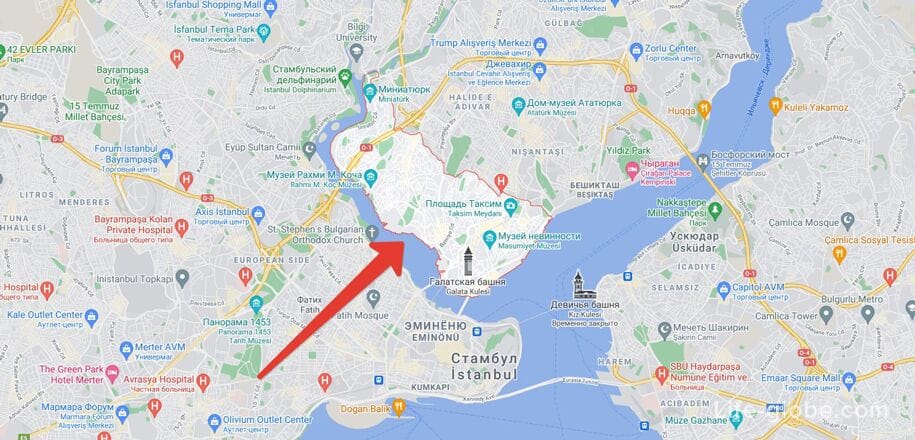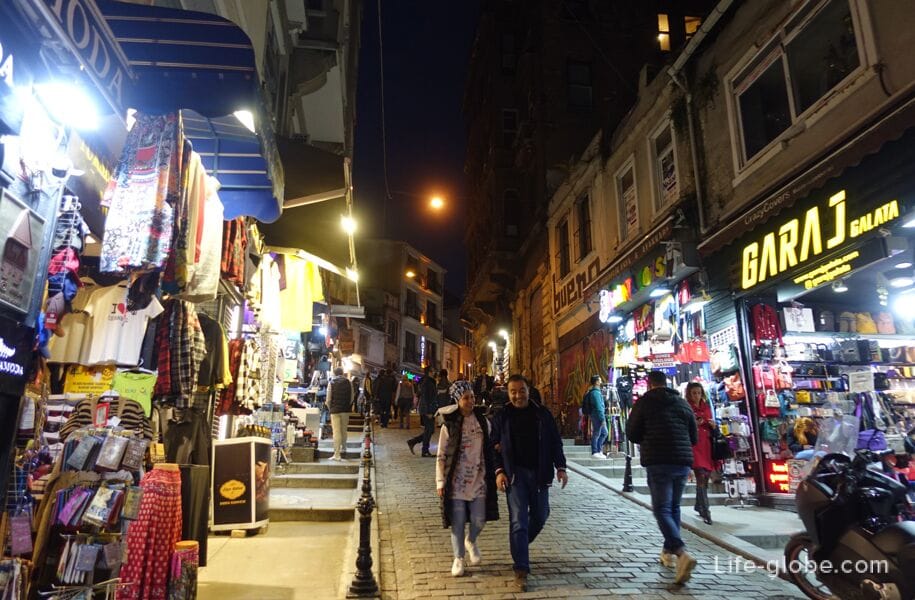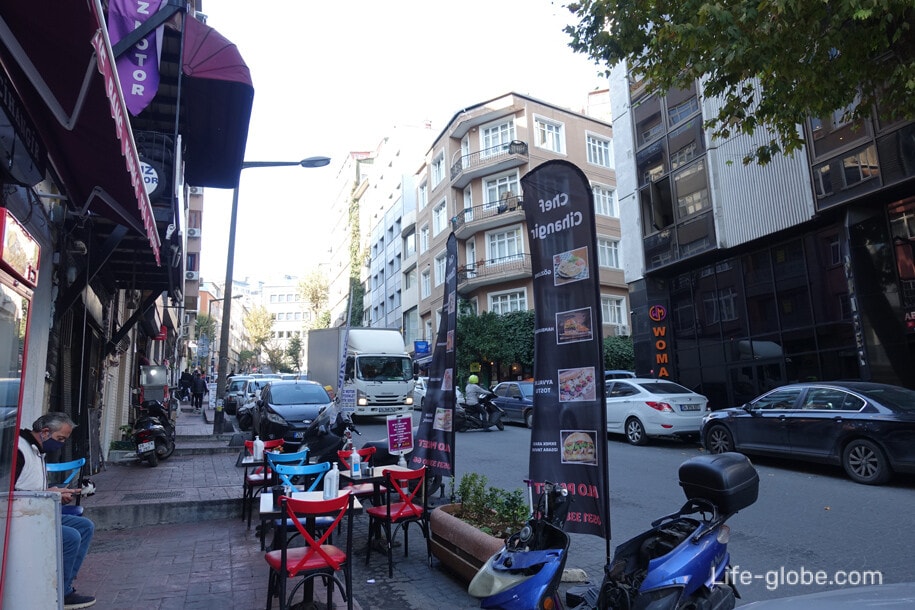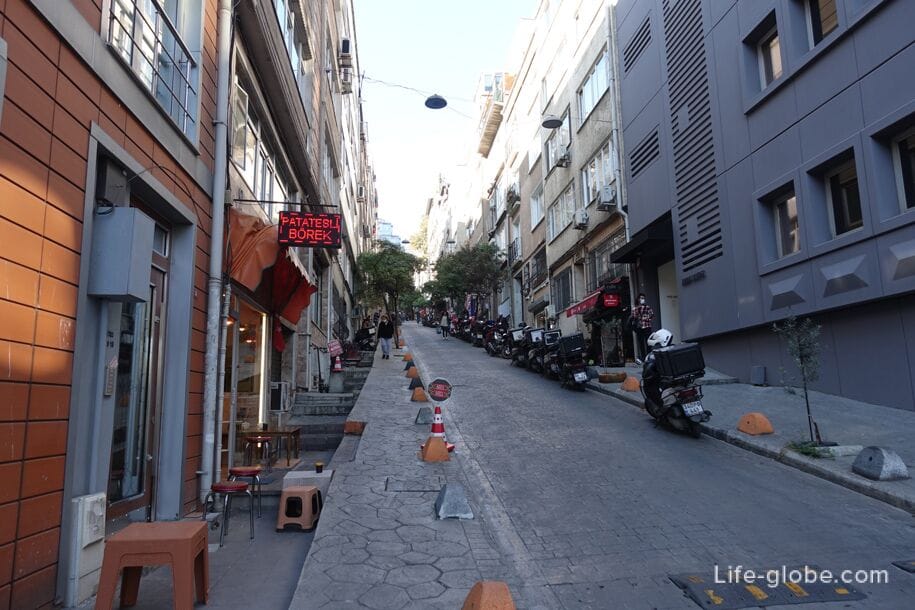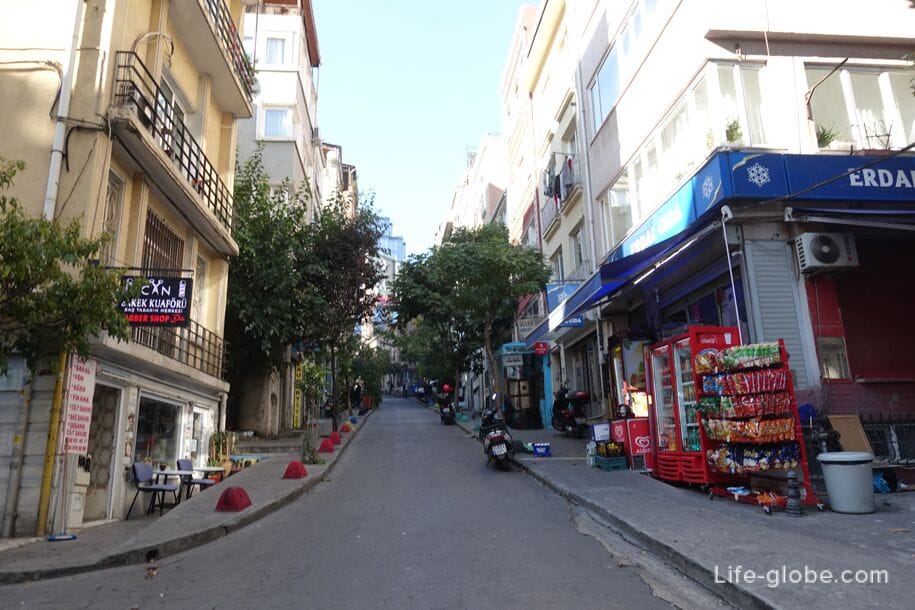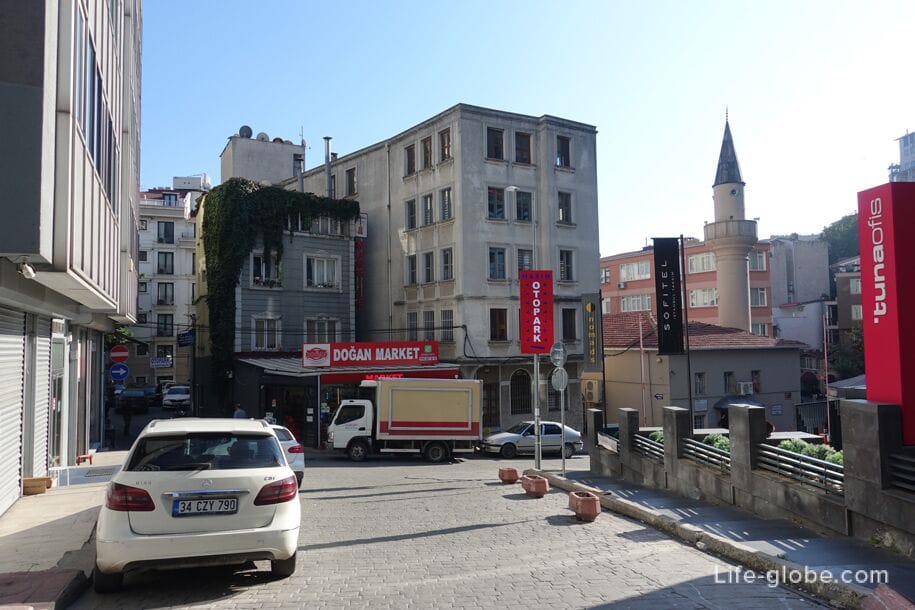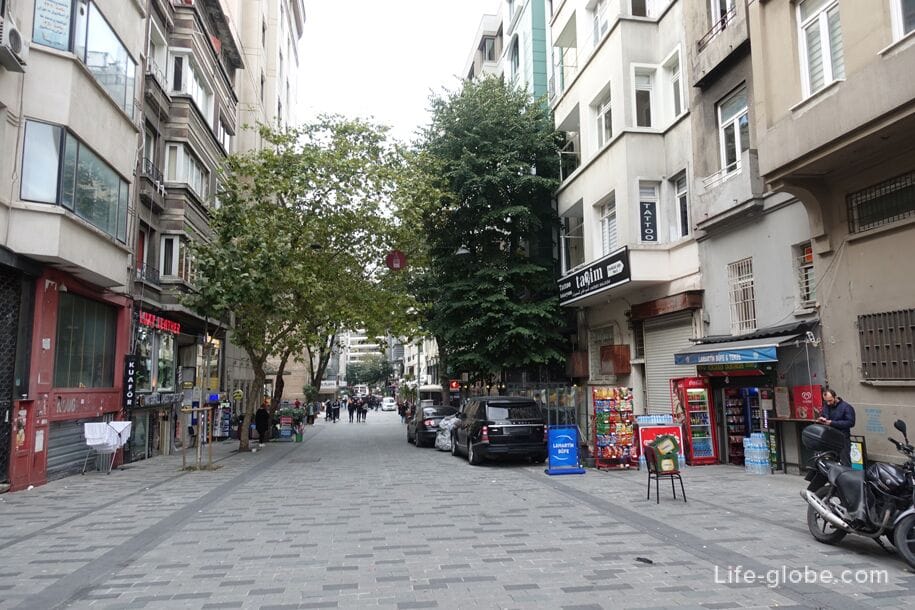
Beyoglu is a lively large district in the European part of Istanbul, which is one of the most famous in the city, after the historic Fatih district.
The Karakoy district is part of the Beyoglu district and the most diverse in terms of the variety of attractions from the quarters in Beyoglu.
The Beyoglu district is home to some of Istanbul's main attractions, including museums, art galleries, the Ainali Kavak summer Ottoman Palace, the Miniature Park, and the city's best observation deck in Galata Tower, Istiklal pedestrian shopping street, the largest square in Istanbul - Taksim, as well as colorful historical quarters, including Karakey.
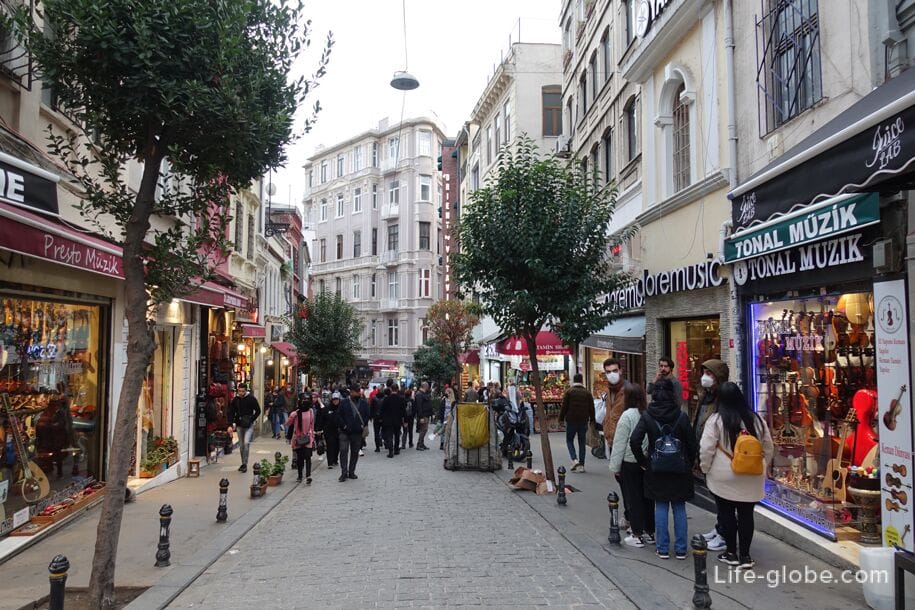
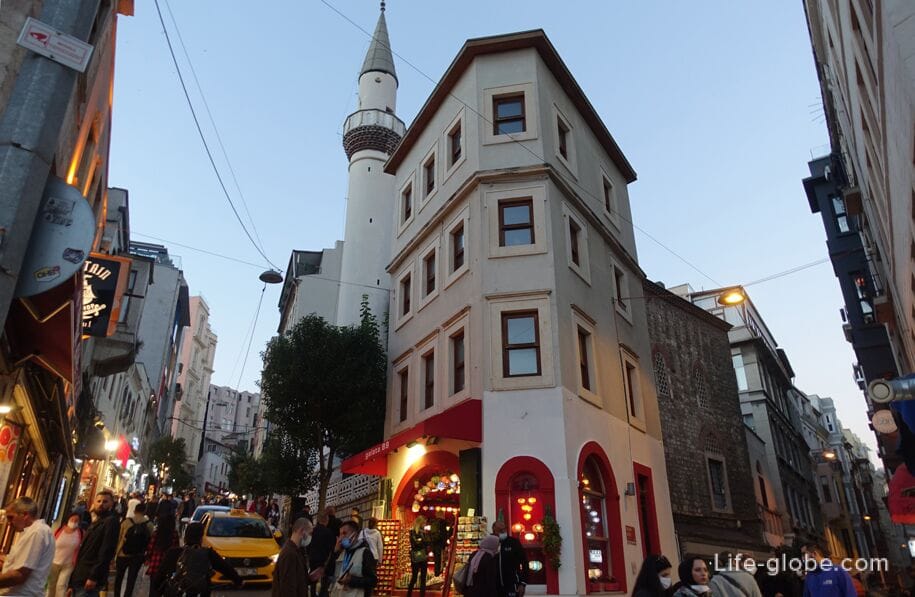
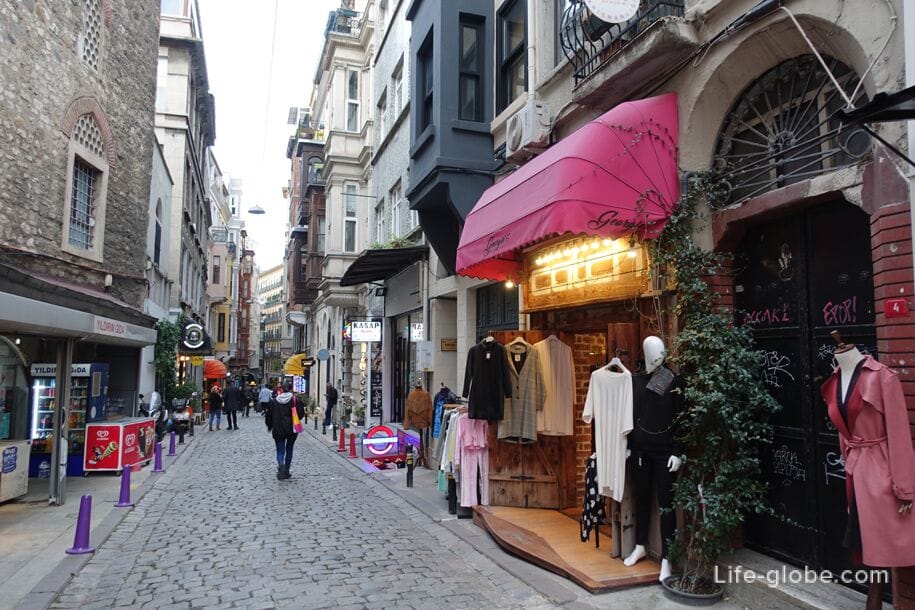
Beyoglu and Karkey are washed by the Golden Horn Bay and the Bosphorus Strait.
View of Beyoglu and Karakey districts from the Bosphorus, Golden Horn and two-level pedestrian transport Galata Bridge (Galata Köprüsü) with restaurants and observation decks on the lower tier, spanning the Golden Horn and connecting the Beyoglu district with the Fatih district.

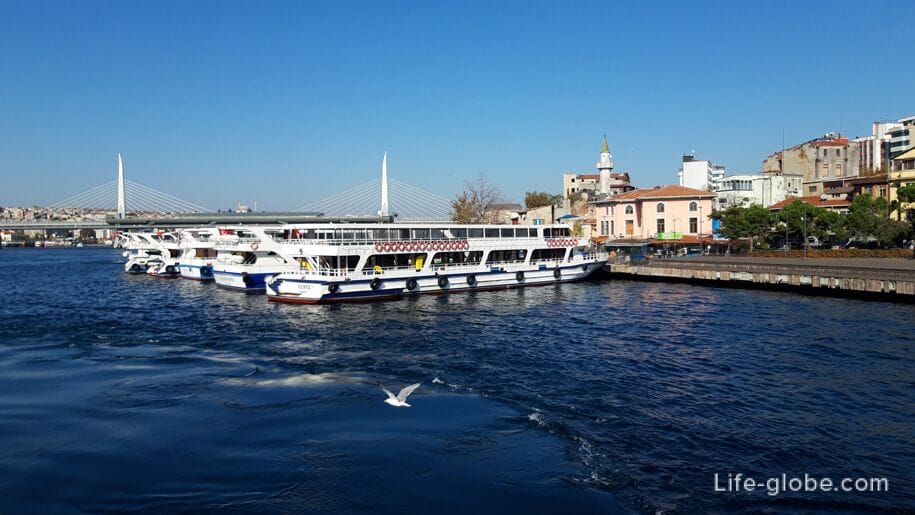
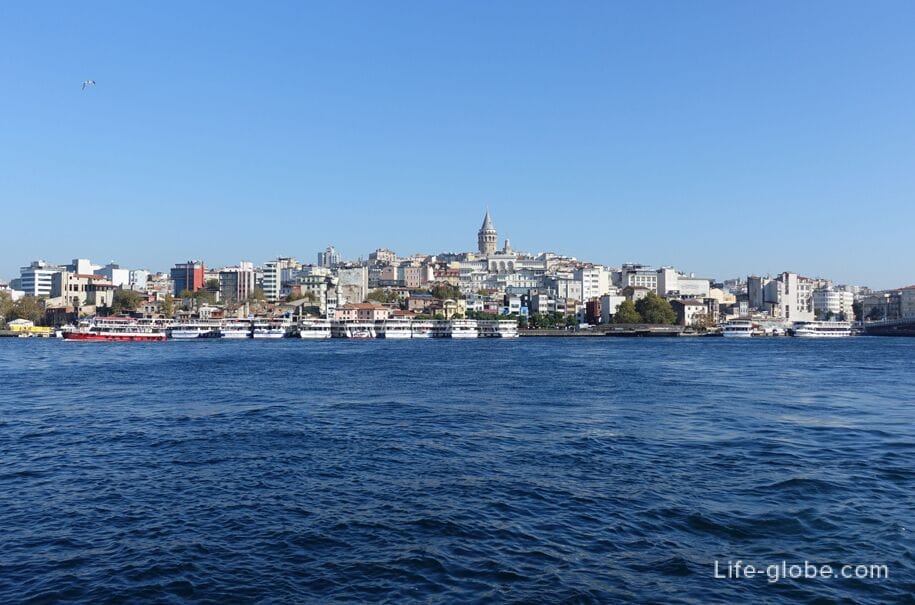

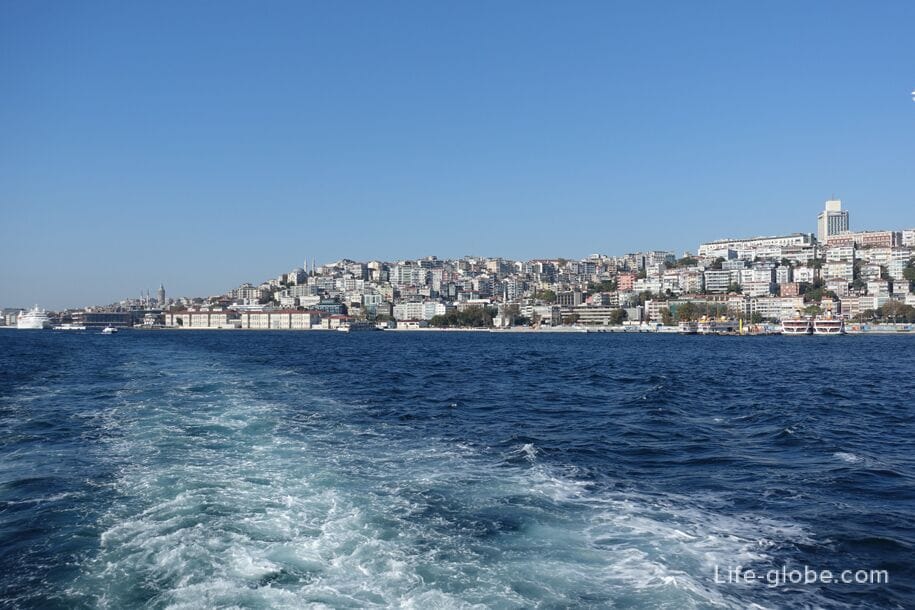
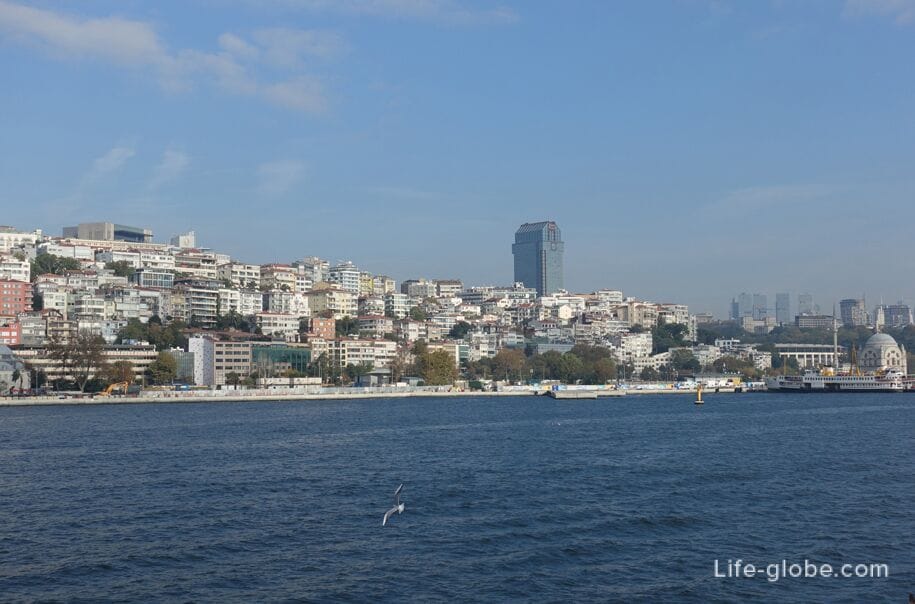
The current territory of the Beyoglu district has been inhabited by man since ancient times.
In the 4th and 5th centuries, these were the suburbs of Constantinople (now the city of Istanbul), which was located on the opposite side of the Golden Horn from Beyoglu (now the Fatih district).
Part of the modern Beyoglu district was known as the Pera region (ΠρΡα, which means "beyond" in Greek), which surrounded the ancient coastal city of Galata, which received its name after the construction of the fortress and the Galata Tower. Now the borders of the former city of Galata roughly, but not completely, coincide with the modern quarter of Karakey.
Today Galata Tower (Galata Kulesi Istanbul), erected by the Genoese in the middle of the fourteenth century (1348-1349), has been restored and is one of the symbols and one of the main attractions of Istanbul.
The height of the tower is 67 meters, the diameter is 9 meters, and the height above sea level reaches 140 meters.
The tower is accessible to visitors. It houses a museum exhibition, and on the upper levels of the tower there are circular (indoor and outdoor) observation decks, giving beautiful panoramic 360-degree views of Istanbul.
Entrance to the Galata Tower and ascent to the observation deck is paid.
Galata Tower website: muze.gov.tr/muze-detay. Learn more about the Galata Tower with photos and description...

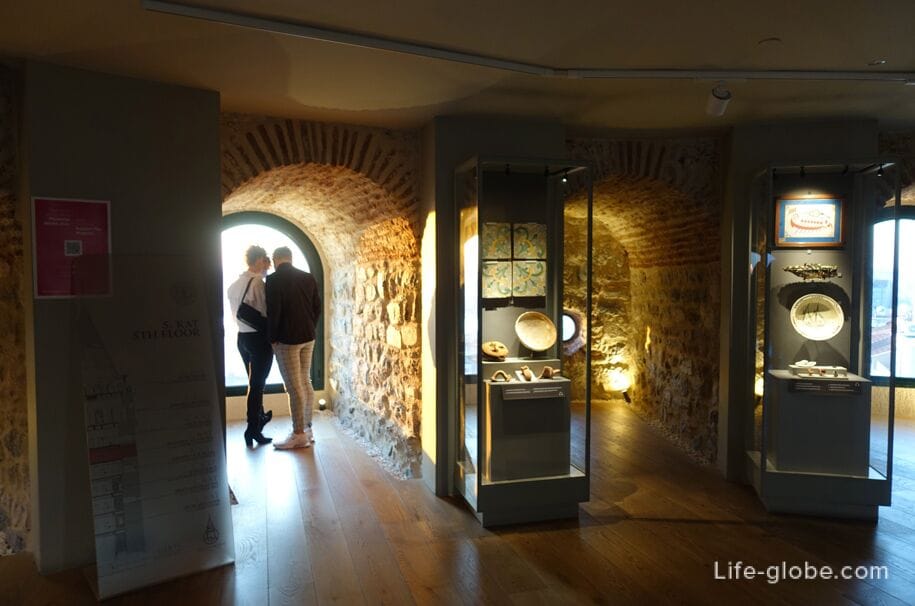
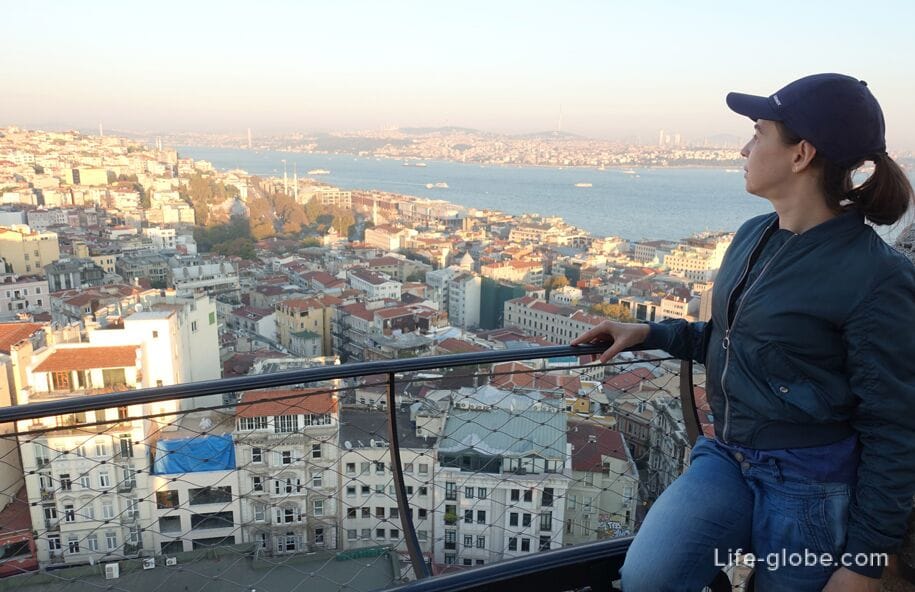

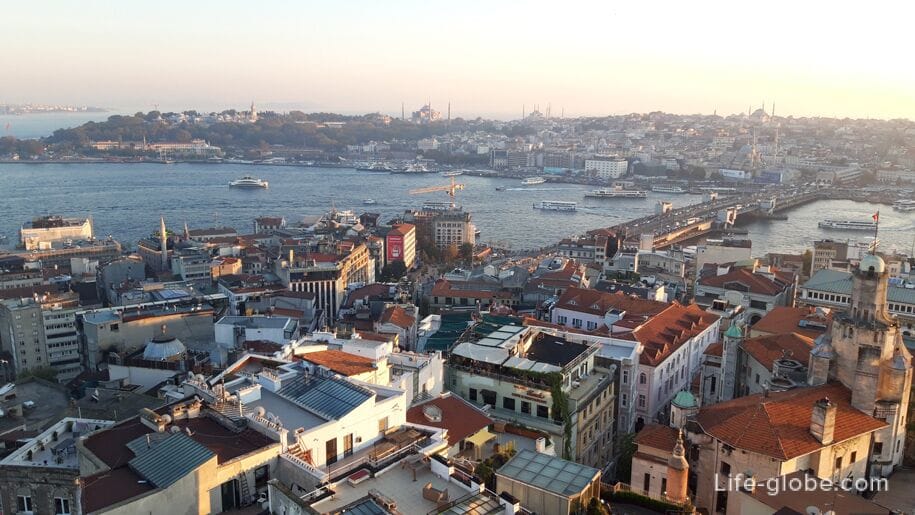
Near the Galata Tower, you can see the small remains of the former defensive walls, the Bereketzade fountain (Bereketzade Çeşmesi) with rich decor and inscriptions, built in 1732, and a small square with a cafe.

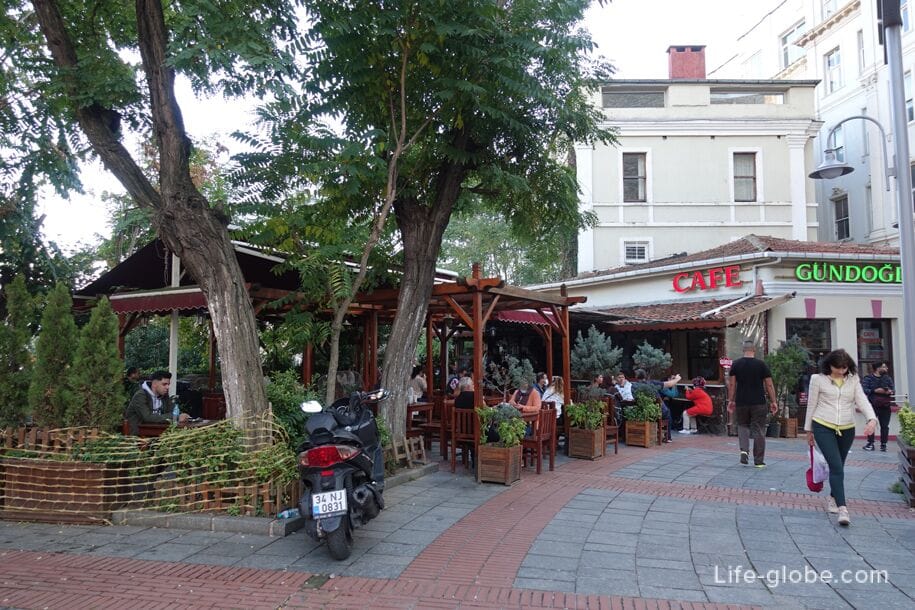
The main square of Beyoglu district is Taksim Square (Taksim Meydanı), which also acts as one of the major central squares of Istanbul, and is now the main transport hub of the city, as well as a walking area with some significant attractions.

The center of Taksim Square is decorated with an 11-meter figured monument of the Republic (Cumhuriyet Anıtı), designed by Italian architect Pietro Canonica and opened on August 8, 1928.
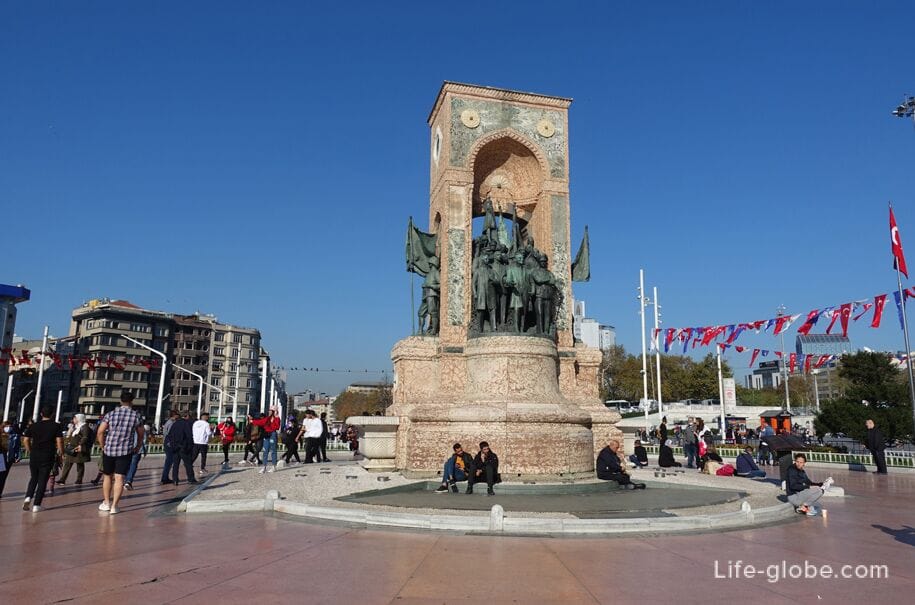
Also notable on the square is the Taksim Mosque (Taksim Camii), erected in 2017-2021, although the plan of the mosque on the square has been developed since 1952.
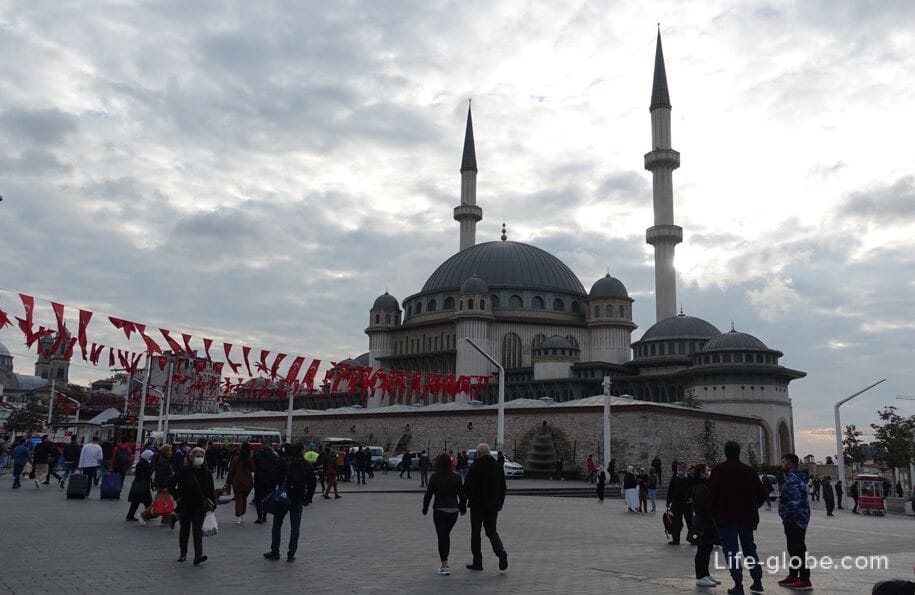
In addition, Taksim Square is surrounded by modern and historical (19th century) buildings, including the Ataturk Cultural Center (Ataturk Kültür Merkezi), with a terrace with an outdoor pool, the 4-star CVK Taksim Hotel Istanbul with a panoramic restaurant and the famous dessert cafe Hafiz Mustafa 1864 (Hafız Mustafa 1864 Meydan) with delicious baklava and lukum.
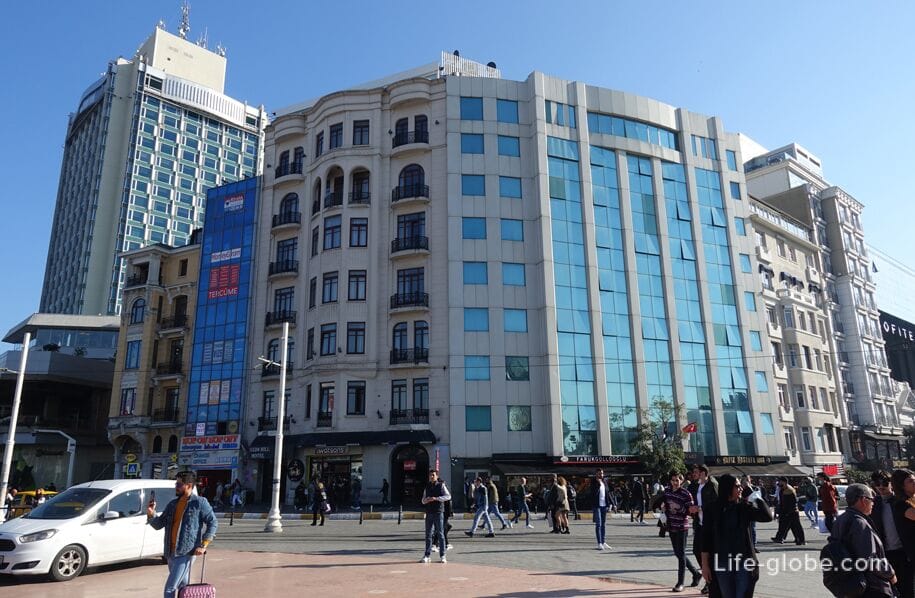
Taksim Gezi Park is adjacent to Taksim Square. More about Taksim Square...

Istiklal (Istiklal Caddesi) is the most famous pedestrian shopping street in Istanbul, which attracts many tourists and locals.
Istiklal Street is 1.4 kilometers long. It stretches from Taksim Square, goes towards the Golden Horn Bay, and ends at Tunel Square, where the station of the historic underground funicular "Beyoglu" is located.
Along the street there are dense rows of buildings, including historical ones (mainly of the 19th - early 20th centuries), which were designed in neoclassical, Neo-Gothic, Renaissance, art-nova and national Turkish styles; there are also buildings in the styles of the first years of the Turkish Republic and a number of later examples of modern architecture.
In the buildings along the street today there are museums, currency exchangers, night clubs, many cafes, kebabs, bars and restaurants, shops, including famous world brands, boutiques and souvenir shops, as well as various accommodation facilities (hotels, apartments)
Istiklal Street runs historical red retro tram "Nostalgia" connecting Taksim Square with Tunel Square. More about Istiklal Street...
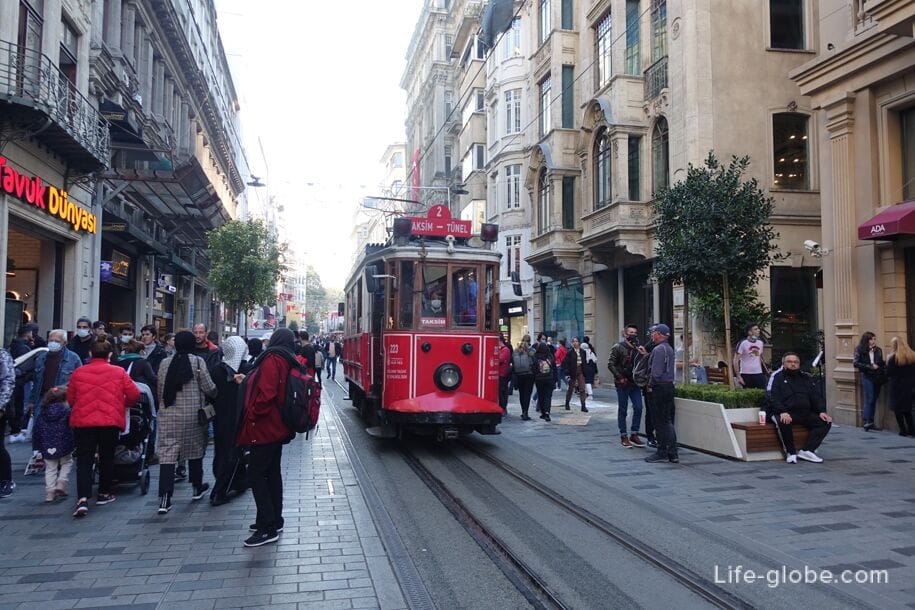
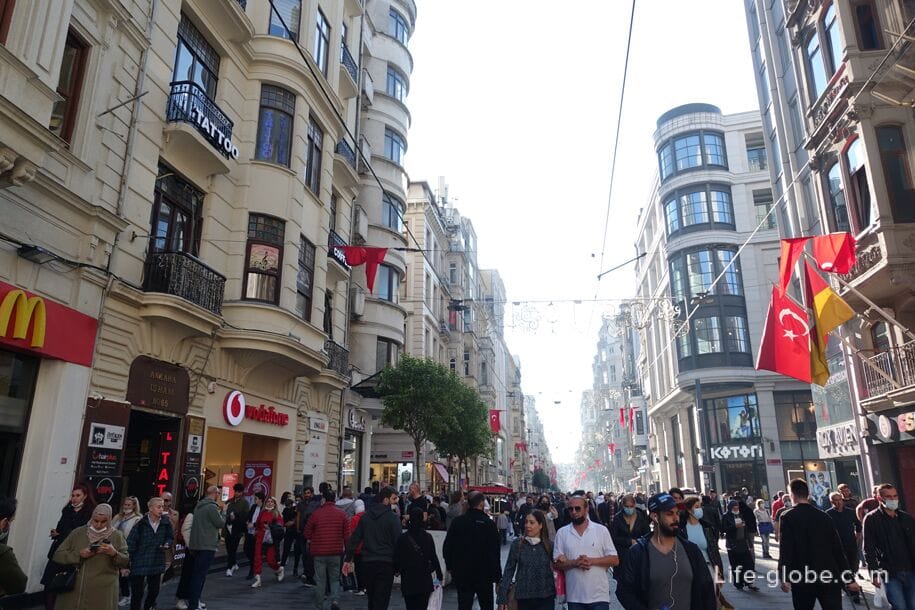
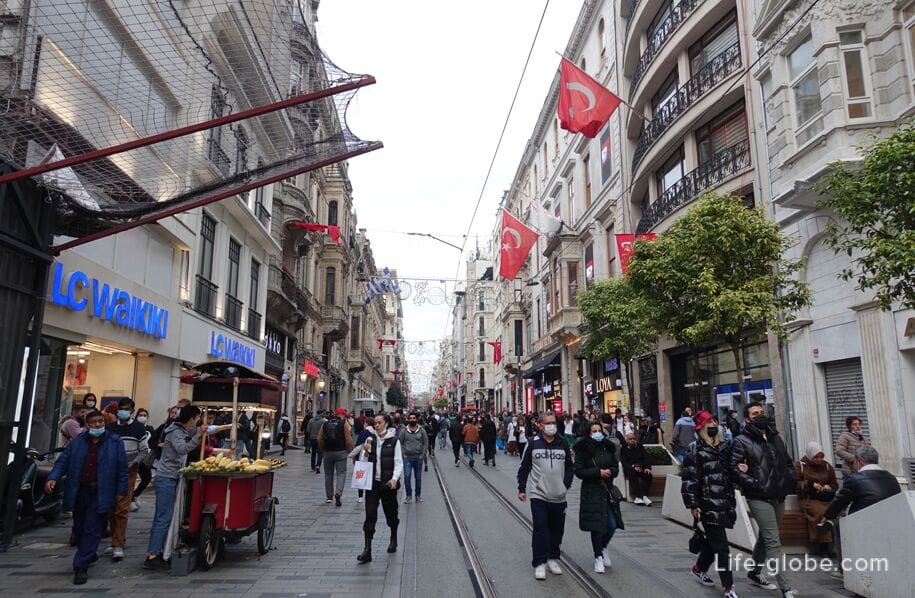
Especially noteworthy along Istiklal Street and near such:
- The Madame Tussauds Istanbul Museum, where wax figures are waiting for you: historical and cultural heroes and about 60 famous personalities from the world of art, sports, cinema and politics from the past to the present, including from Turkey and international stars.
The museum's website: madametussauds.com/istanbul;
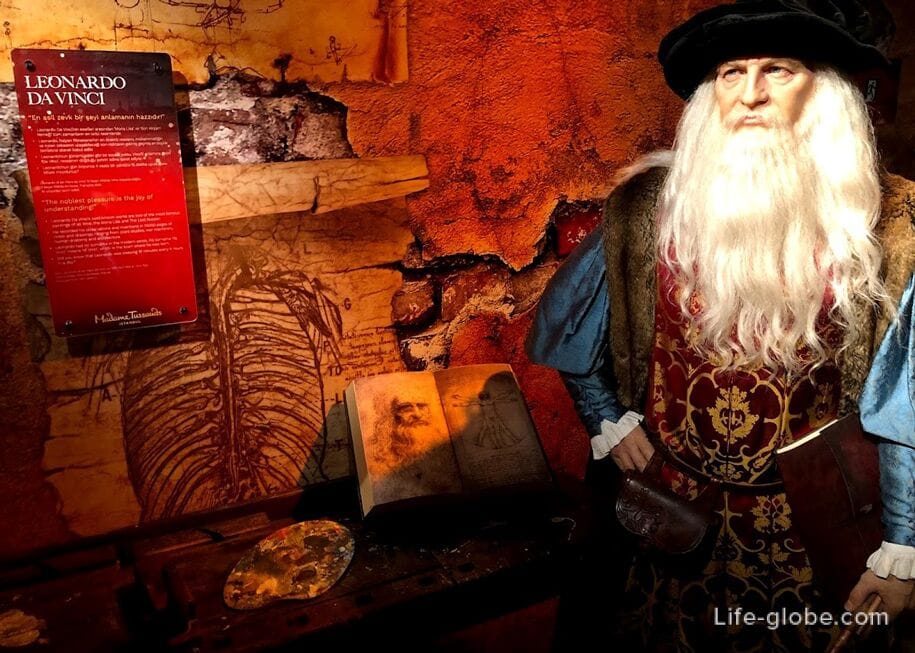
- Flower Passage (Çiçek Pasajı) is a historical covered gallery, opened in 1876 and characterized by exquisite architecture and a courtyard inside which restaurants and shopping shops are located;
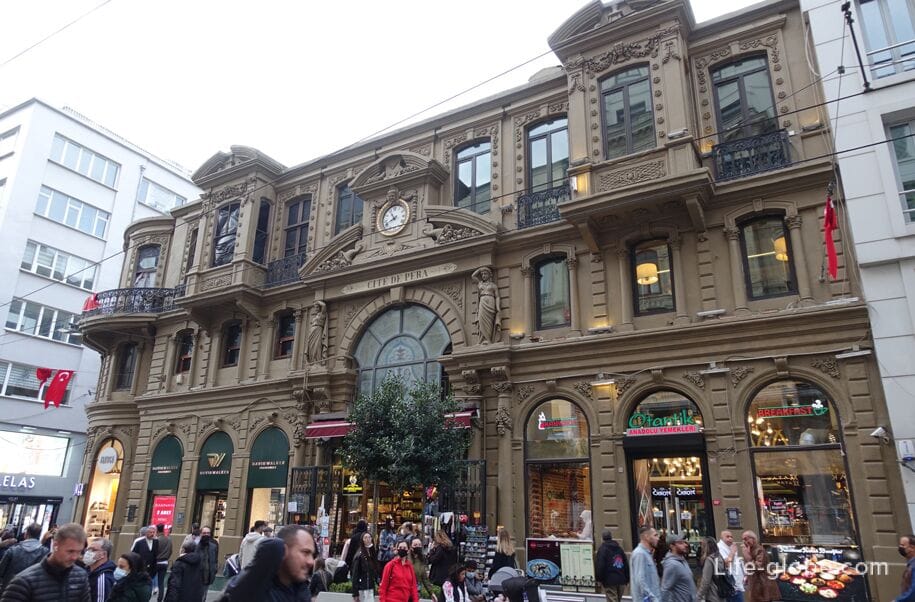
- Galatasaray Lyceum (Galatasaray Lisesi) is the oldest secondary school in Turkey, founded in 1482. It is also the second oldest Turkish educational institution after Istanbul University, founded in 1453;

- The European Passage or Avrupa Pasajı (Europe Pass, Avrupa Pasajı) is a historical shopping gallery that has a mirrored arcade (Aynalı Pasaj) and is made in neoclassical style.
The passage was built by the Ottoman Armenian merchant Onnik Dyuz in 1874.
Today there are 22 shops in the shopping center, with a predominance of souvenir shops, antiques, clothing, carpets and jewelry;
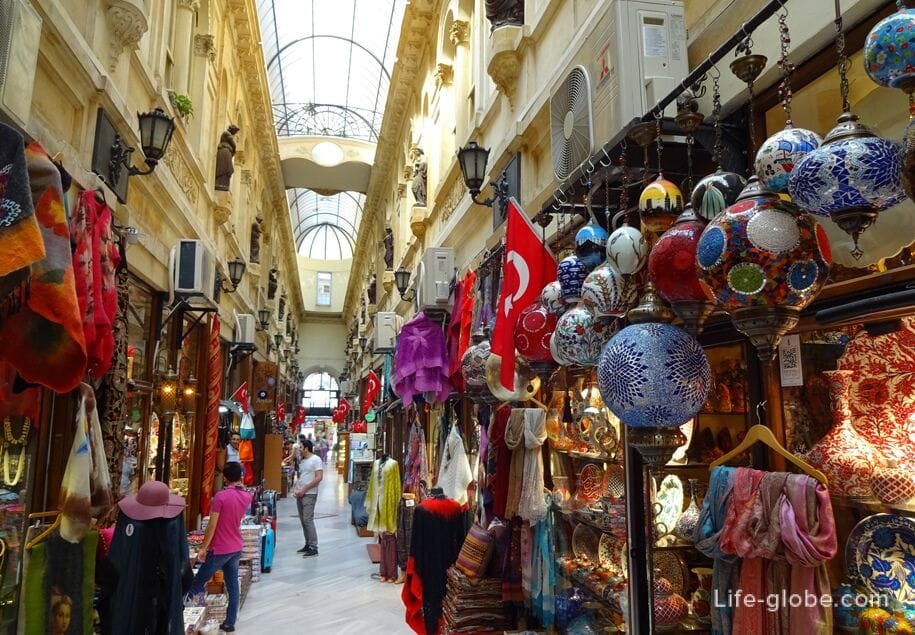
- Galata Mevlevihanesi Museum (Galata Mevlevihanesi Müzesi) is a museum in a building belonging to a religious movement, where you can see ritual dances dedicated to the culture of the dervishes.
The museum's website: muze.gov.tr/muze-detay;

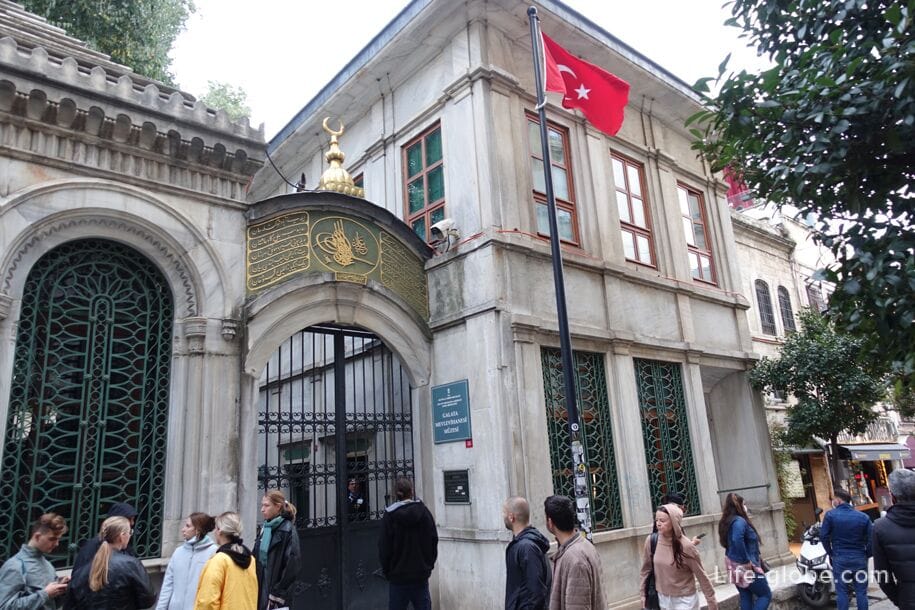
- The Church of St. Maria Draperis (Santa Maria Draperis Kilisesi) is a Roman Catholic church built in 1584 and is one of the oldest Roman Catholic parishes in Istanbul;
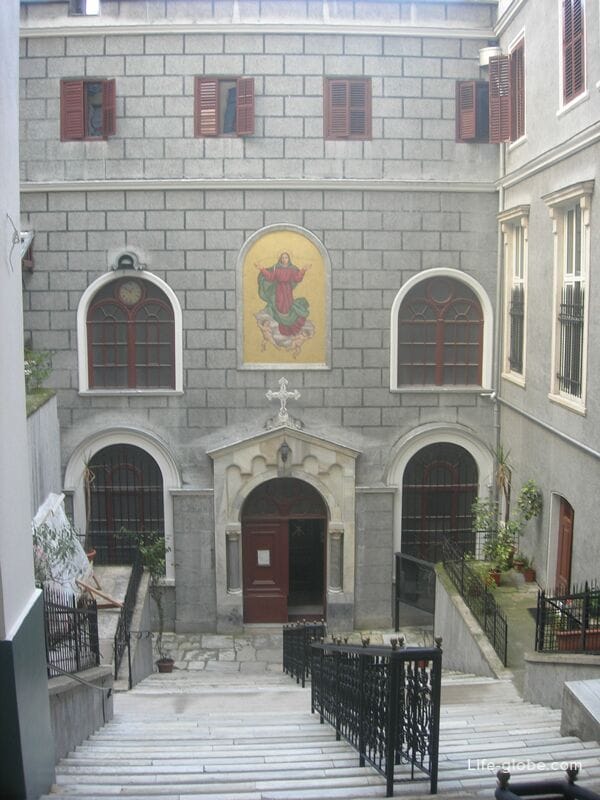
- St. Anthony of Padua Cathedral (Sent Antuan Kilisesi) is a church in the Venetian Neo-Gothic style, built by the Italian architect Giulio Mongeri and opened in 1912;
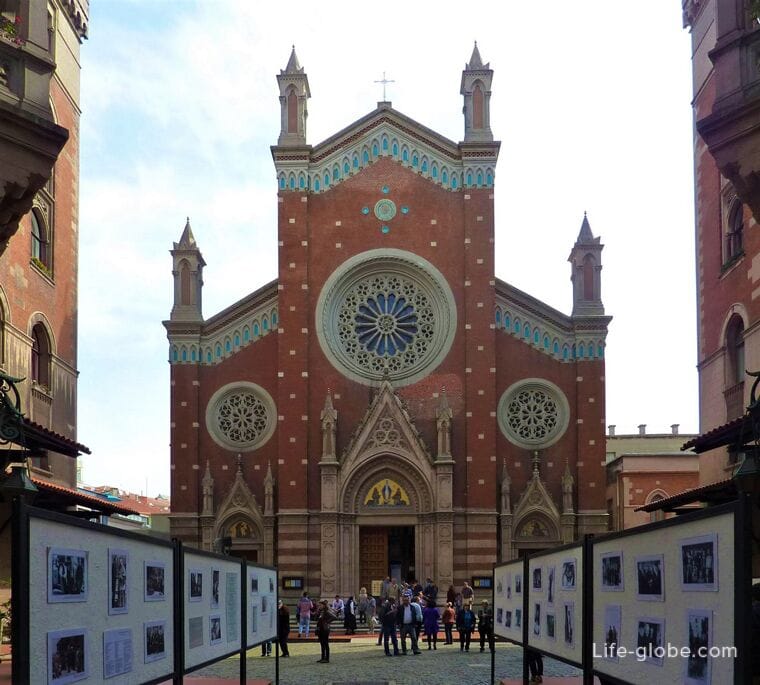
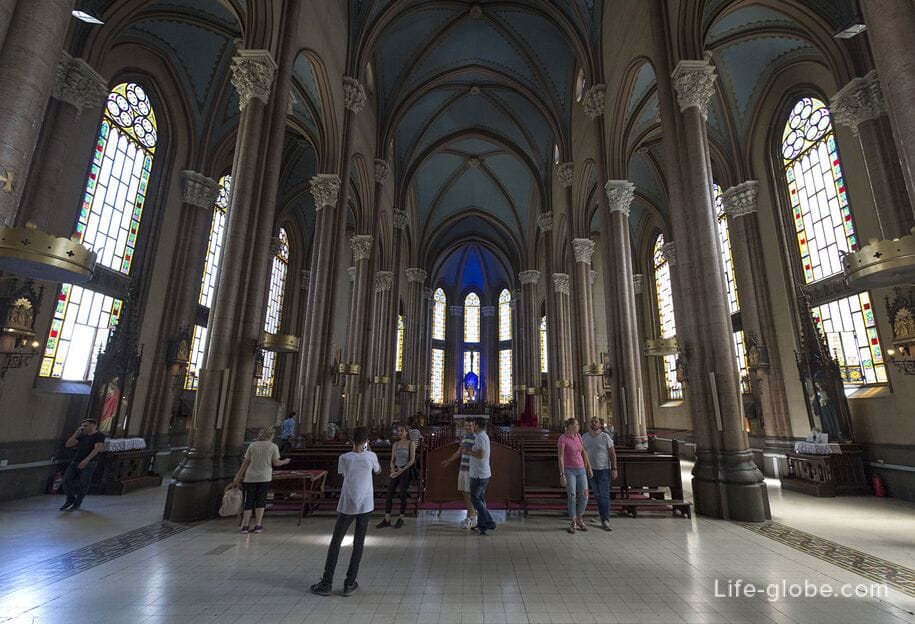
- the small mosque of Beyoglu Huseyin Agha (Hüseyin Ağa Camii);
- The Church of the Holy Trinity (Aya Triada Rum Ortodoks Kilisesi) is a Greek Orthodox church opened in 1880.
The temple stands out with stained glass windows, gilded domes and elegant paintings on the ceiling.
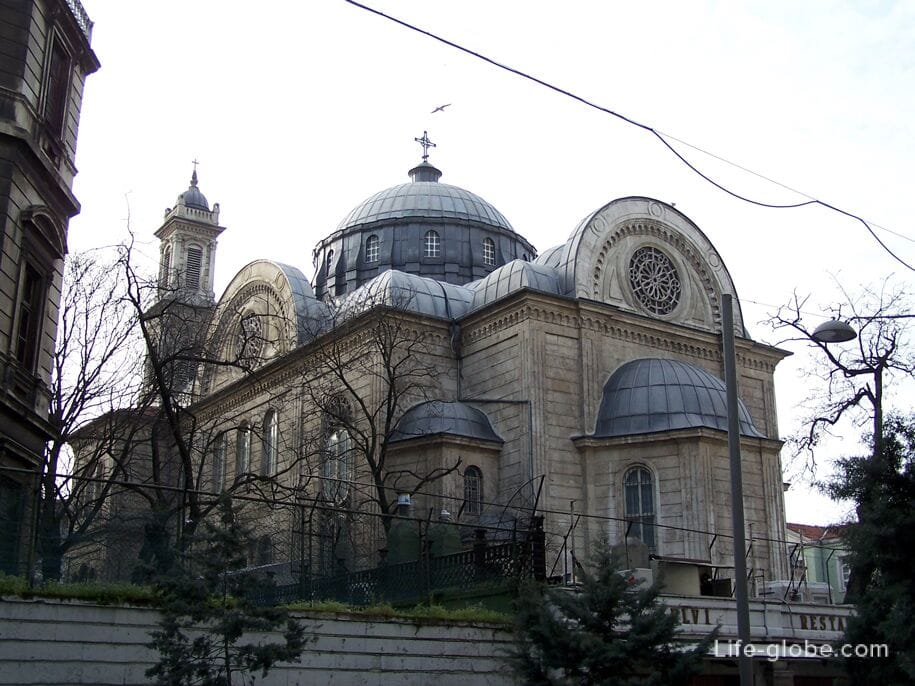
The Tunel is an underground historical funicular, which was opened in 1875 and is now the city's public transport and one of the oldest currently operating funiculars of its kind.
The underground funicular line is designated as F2 Karaköy - Beyoğlu (Karaköy - Beyoğlu).
The upper station is called Beyoglu and is located on the square of the same name, where Istiklal Street ends; and the lower station of the funicular, called Karakoy, is located near the Galata Bridge.
The fare in Tunel is integrated into the citywide public transport fare system in Istanbul. Istanbul transport cards are also valid. Learn more about the Tuner with a photo, description and website...

The Karakoy Fish Market (Karaköy Balık Evi) is a very colorful place where fish and seafood are sold.
Most of all, this market is attractive to tourists because it has a cafe where you can taste fish and seafood dishes.
The market is located near the Galata Bridge and the Karaköy Istasyonu Ferry pier.
Below Taksim Square and Istiklal Street, in the direction of the waters of the Bosphorus and the Golden Horn, including in the Karakey quarter, the following attractions and museums are located:
- The Museum of Jewish Culture in Istanbul (Quincentennial Foundation Museum of Turkish Jews) is a cultural center created to inform society about the traditions and history of Turkish Jewry and about the historical and cultural relations between Jews and Muslims.
The museum is located in the building of the Zülfaris Synagogue, at the address: Bereketzade, Büyük Hendek Cd. No:39, 34421 Beyoğlu/Istanbul, Turkey.
The museum's website: muze500.com/index.php;
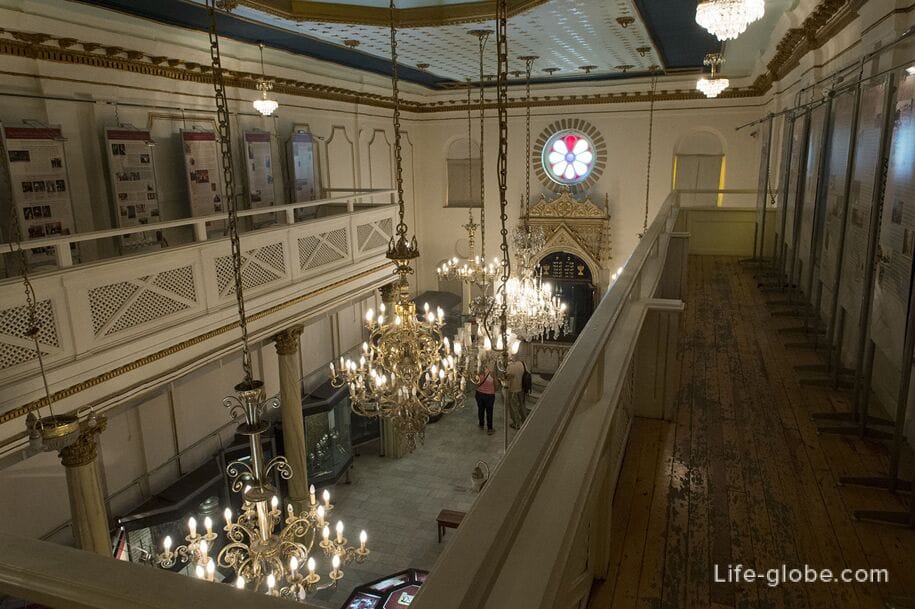
- Orhan Kemal Literary Museum, dedicated to Turkish literature and named after the writer Orhan Kemal (1914-1970).
The museum presents photographs of Kemal's personal life taken by Ara Guler, family photographs, original first editions of books, personal letters, criticism, articles and dissertations about the writer's works. Orhan Kemal has a typewriter and other personal belongings in his office. The museum also presents a death mask of the writer.
The museum's website: orhankemal.org/index.html;

- The Museum of Innocence (Masumiyet Müzesi), opened by the writer Orhan Pamuk and connected in meaning with Pamuk's novel of the same name.
The museum's website: masumiyetmuzesi.org;
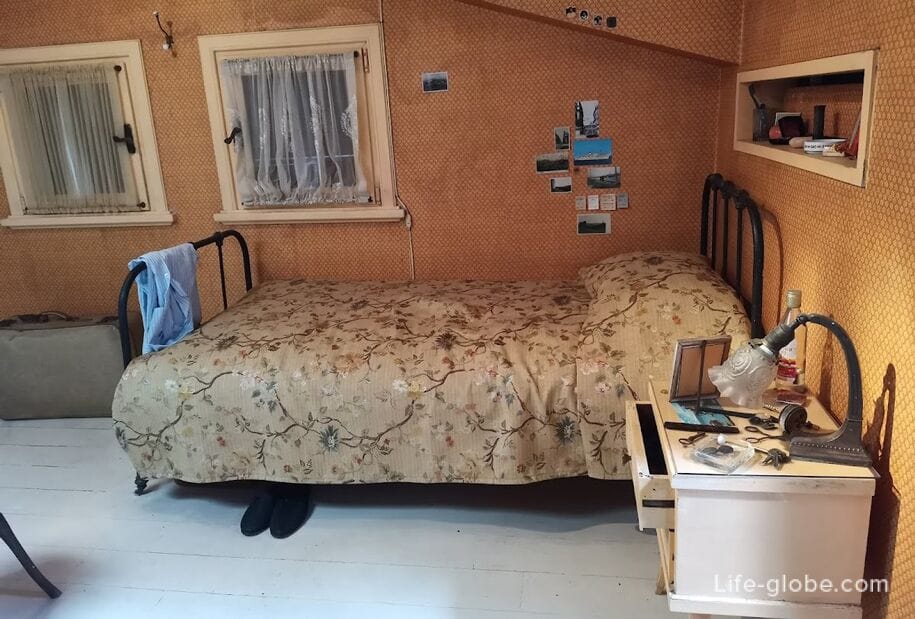
- the Museum of the Ottoman Bank (Osmanlı Bankası Müzesi) with an underground money vault.
Address museum:Arap Cami Mahallesi, Bankalar Caddesi No.11, Karaköy;
The museum is located on Bankalar Caddesi Street, which was the financial center of the Ottoman Empire;

- Neve Shalom Synagogue (Neve Şalom Sinagogu), which is the central and largest Sephardic synagogue in Istanbul.
The emergence of the synagogue began in the late 1930s, when the Jewish population in the Istanbul districts of old Pera and Galata increased, and it was decided to demolish the Jewish elementary school (1949) and build a new synagogue in its place. The construction of the synagogue was completed in 1951. The architects of the synagogue were young Turkish Jews Elo Ventura and Bernard Motola.
Synagogue address: Bereketzade, Büyük Hendek Cd. No:39, 34421 Beyoğlu/Istanbul, Turkey;
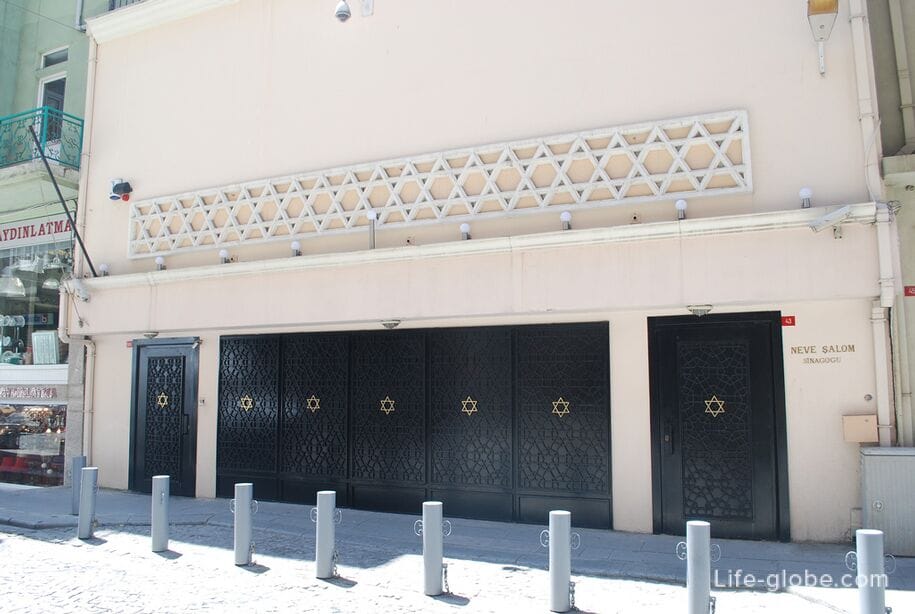
- the Church of Saints Peter and Paul (Sen Pier ve Sen Paul Kilisesi), which is one of the main Catholic churches in Istanbul and plays an important role because it owns an icon of the Virgin of the Hodegetria type, which was originally located in the Dominican church in Kaffa (Crimea).
After in 1475 Sultan Mehmed II the Conqueror transformed the Dominican Church of St. Paul (now an Arab Mosque), located nearby, into a mosque, in 1476 the Dominican monks moved two hundred meters to the east, into a house with land belonging to the Venetian nobles Angelo, and where there was a small chapel dedicated to St. Peter and St. Peter To Pavel.
On April 20, 1535, the old Zaccaria ceded the house to the Dominicans in exchange for a monthly candle offering and a weekly mass for the souls of himself and his parents. In 1603-1604, the chapel was rebuilt into a large church with a monastery.
In 1640, a large icon of the Odigitria type (originally located in Kaffa), belonging to the Dominican church of Santa Maria di Constantinople, located inside the fortress city of Istanbul and turned into a mosque in the same year, was transferred to the walls of the church. In 1660, the church of Saints Peter and Paul completely burned down along with the adjacent monastery. Since the destruction was complete (with the exception of the icon, which was saved), according to the law, the land was returned to the Ottoman government. But, thanks to the intercession of the European powers, in 1702 it was possible to build a new church again. Since 1706, after the Dominicans refused to deliver the icon of the Hodegetria to Venice, the Republic of Venice, which had been financially supporting the monks before, stopped paying subsidies to the church. Around the same years, the icon was partially rewritten (the mantle of the Virgin now looks embroidered with French lilies), so perhaps only her face and chest are original. The complex burned down again during the great fire in Galata in 1731 and was rebuilt from wood.
In 1841-1843, the Swiss-Italian brothers Gaspare and Giuseppe Fossati erected the present monumental church building.
The church is made in the form of a basilica with a four-aisled altar, contains several relics and has a crypt;

- Arab Mosque (Arap Camii / Arap-Jami), formerly known as St. Paul's Church, the origin of which is filled with legends.
According to one version, the shrine belongs to the ancient mosques of Istanbul and was erected in 717. At the time of the Byzantines, it was converted into a Catholic church, and later again transferred to a mosque.
According to another version, the church was built in the early 1200s at the monastery of the Dominican Order and dedicated to Saints Paul and Domenico.
In 1475 Sultan Fatih Mahmed II the Conqueror turned the church into a mosque. Twenty years later, the mosque became known as the "Arab Mosque", and some Andalusian Arabs expelled from Spain, settled in the surrounding areas. Another reason why the mosque is attributed to the Arabs is that the old bell tower, turned into a minaret, resembles the original minaret of the famous Umayyad mosque, built in Damascus in 714.
Today the mosque has been restored, has a Gothic style with a tower, wooden columns and a decorative wooden ceiling;
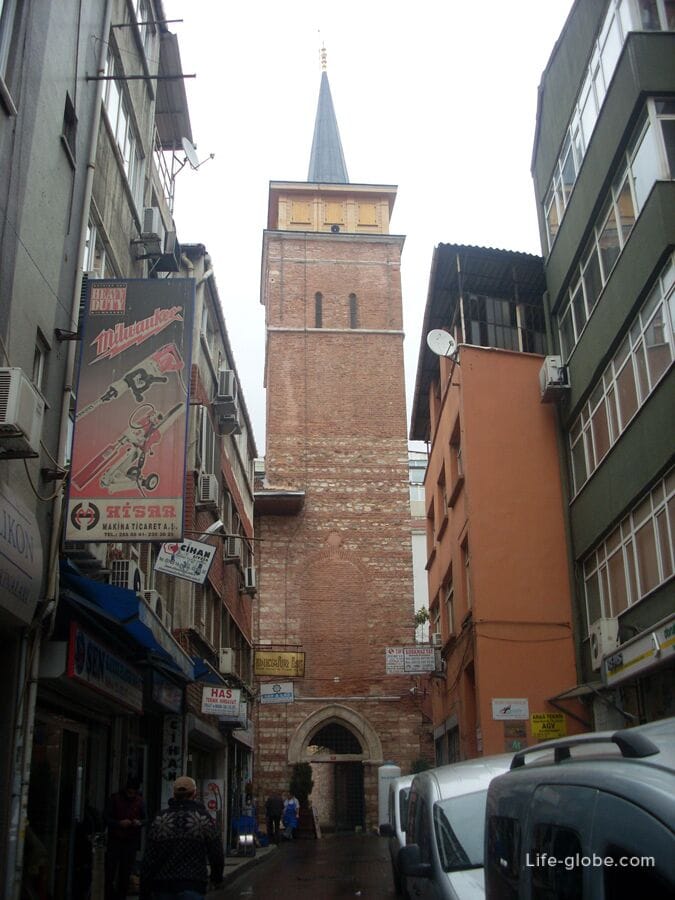
- SALT Galata Cultural Center, where exhibitions, scientific conferences, seminars are held. There is also a cafe with a terrace and a library with access to the former bank vault.
The building of the center itself is an architectural monument erected at the end of the 19th century under the direction of architect Alexander Vallori and modernized with the help of the architectural bureau Mimarlar Tasarym.
Center address: Azapkapı, Bankalar Cd. No:11, 34420 Beyoğlu/Istanbul, Turkey.
The center's website: saltonline.org;
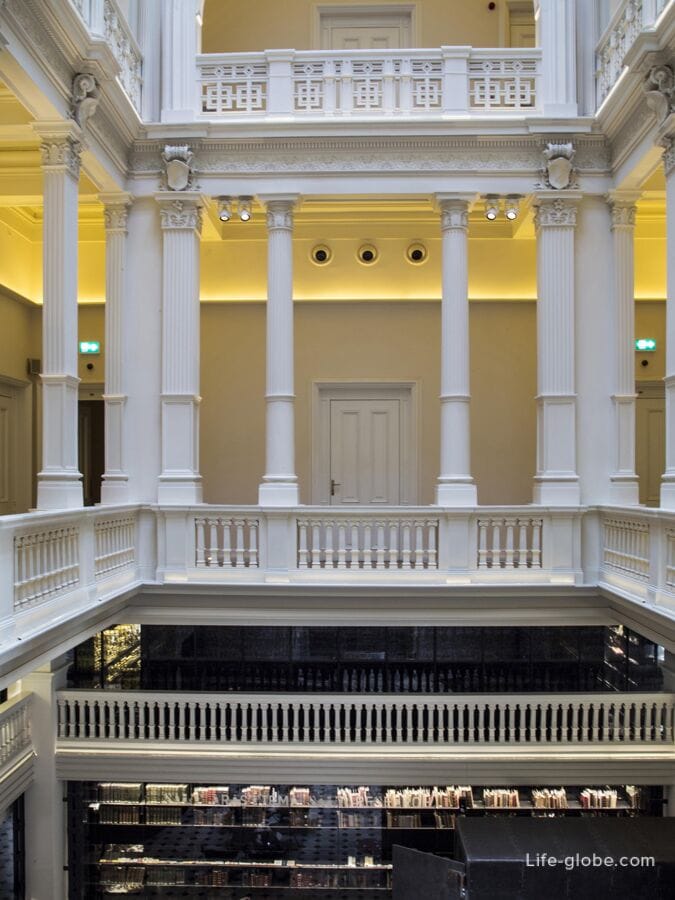
- Kamondo stairs or Kamondo steps (Kamondo merdiven) is one of the most famous and photographed pedestrian stairs-sights of Istanbul.
This winding staircase was designed with a unique combination of neo-Baroque and early Modern styles, and built around 1870-1880 by Abraham Salomon Kamondo;
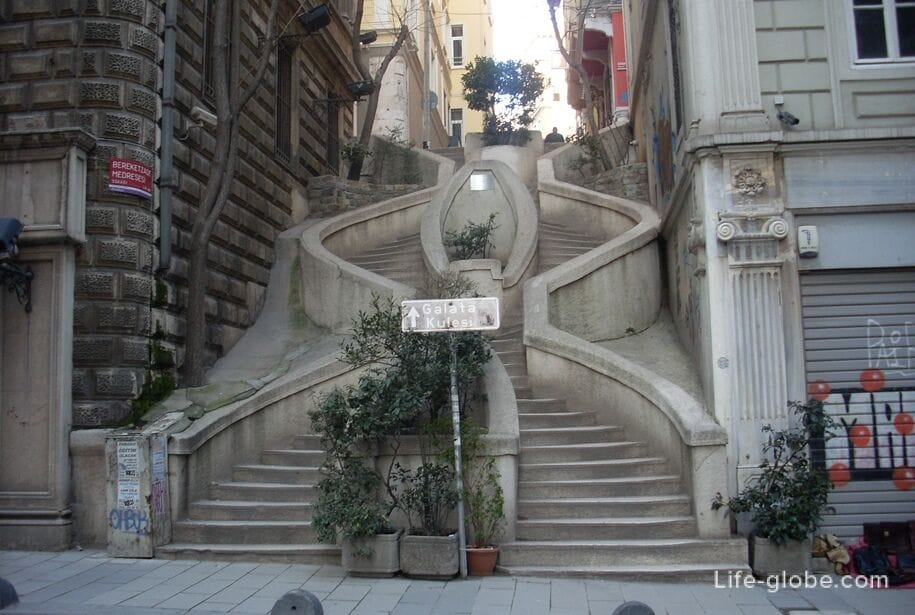
- Karakoy PALACE is a famous building built in 1920 with elements of neo-Byzantine style, which is now occupied by a bank.
Palace address: Kemankeş Karamustafa Paşa, Havyar Haniçi Sk., 34425 Beyoğlu/Istanbul, Turkey;
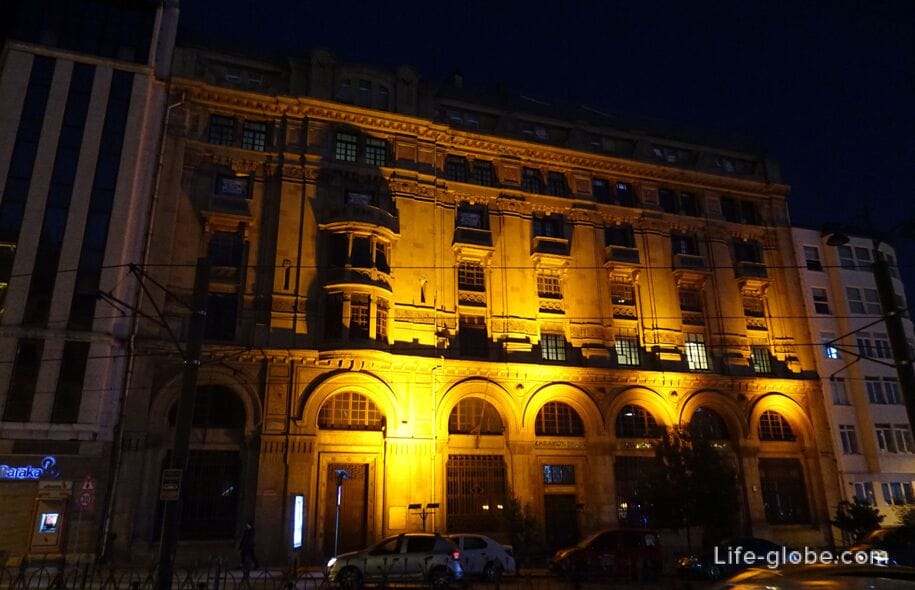
- underground Ottoman mosque or Kunshurlu (Yeraltı Camii, Kurşunlu Mahzen) with arched structures, green lighting and a tomb.
The exact year of construction of the shrine is unknown. It is known that originally it was a fortress tower built by Abdulaziz's son Omer, with a church in underground casemates, which was later turned into a mosque and completed.
Mosque Address: Kemankeş Karamustafa Paşa, Kemankeş Cd. No:23, 34425 Beyoğlu/Istanbul, Turkey;
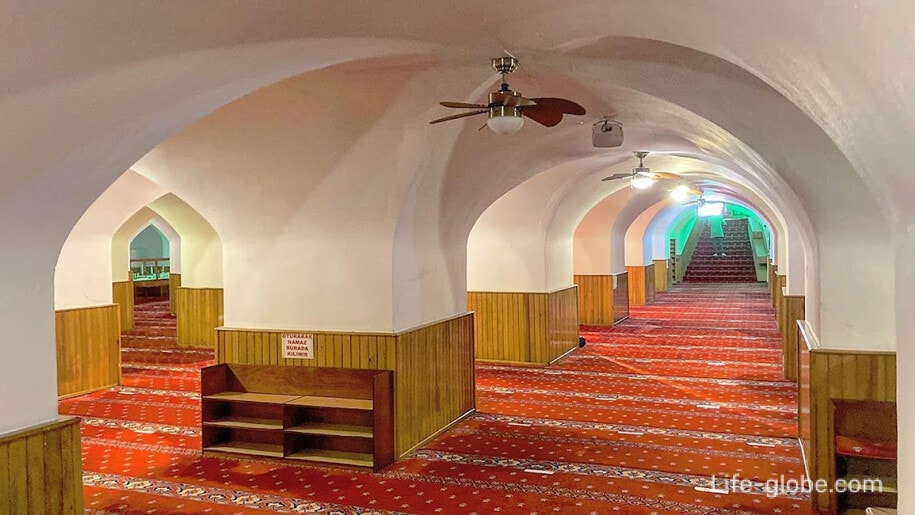
- The French Church of Saint Benedict (Saint Benoit Kilisesi ve manastırı), which is important for historical reasons, since it was founded in 1427 and was the oldest Catholic church in Istanbul.
The complex now houses the Lyceum Özel Saint Benoit Fransız Lisesi (private French secondary school of Saint Benoit);
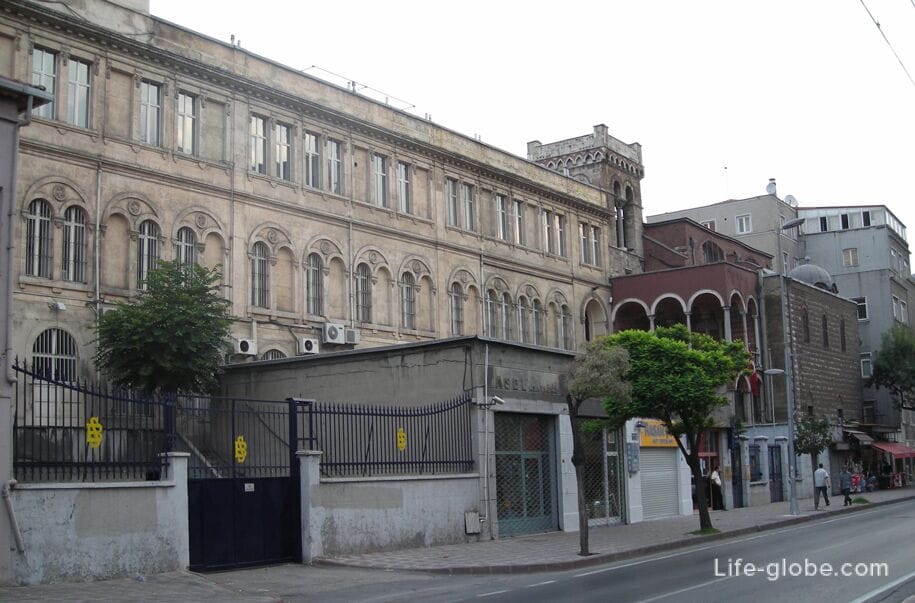

- street with umbrellas (Hoca Taksin sok., Karaköy), where there are cafes with tables in the open air;
- Saint Panteleimon Russian Orthodox Church (Aya Panteleymon Kilisesi) is the only Russian Orthodox church in Istanbul.
The uniqueness of this church is that it is located on the last tier of a multi-storey residential building.
History says that households in this part of the Karakey quarter were built in the second half of the 19th century specifically for pilgrims from Russia making a stop in Istanbul on their way to Jerusalem, as well as housing for monks providing travelers with everything they need. At that time, a place was reserved for prayers on the last tier of the largest house. After the revolution of 1917, emigrants fled from Russia to Istanbul, and Karakey became their haven, and the small church of St. Panteleimon served as a spiritual center.
Church address: 6 Kemankeş Karamustafa Paşa Hoca Tahsin Sokak, Karaköy, D:19, 34425 Beyoğlu/Istanbul, Turkey;
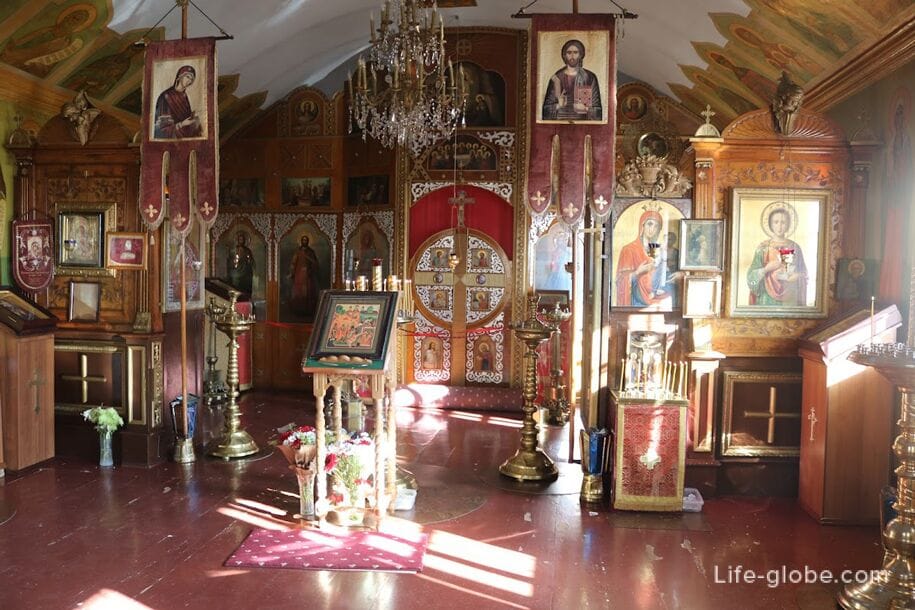
- The Armenian Church of St. George the Enlightener (Surp Krikor Lusavoriç Ermeni Ortodoks Kilisesi, Galata Surp Krikor Lusavorich) is the oldest of the famous Armenian churches built in Galata (Karakey) during the period of Genoese rule.
The exact date of construction of the church is unknown, but it is believed that it is 1431. Records dating back to 1360 were also found that the Church of St. Sarkis (Surp Sarkis Kilisesi) was located on the site where the church of St. George is now located.
During the history of the church suffered from fires and was rebuilt.
In 1958, during road construction works, the authorities decided to expand the street of Kemeralty, where the church was then located. At that time, the church was demolished, and a new church was built on part of the land remaining from the new road. The modern church building was erected under the direction of architect Bedros Zobyan in 1961-1965 according to Armenian architectural canons;
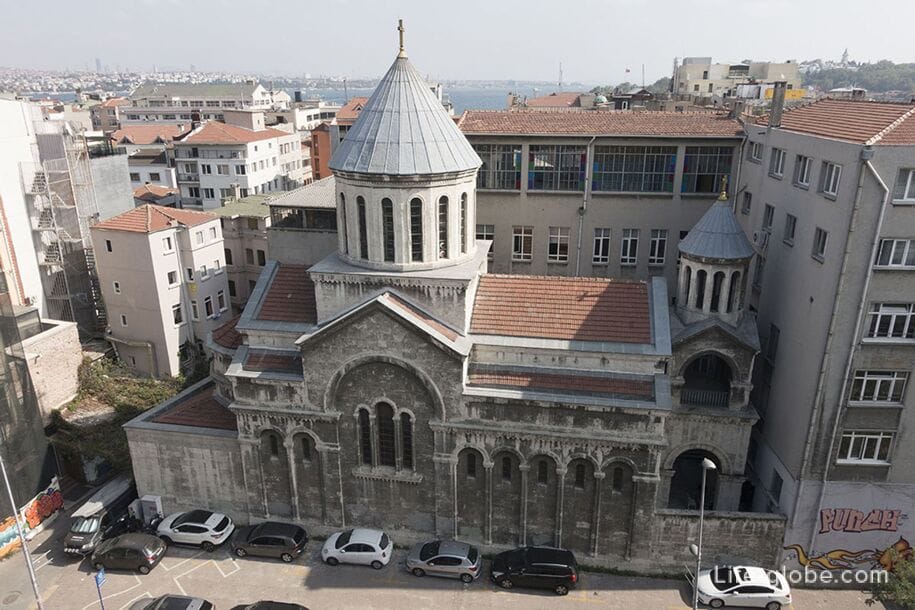
- Kilic Ali Pasha Hammam (Kılıc Ali Pasa Hamam) is one of the oldest Turkish baths in Istanbul.
The hamam was built in 1580-1587 by architect Mimar Sinan, and was a complex of Kılıç Ali Pasha (Kılıç Ali Paşa), consisting of a mosque with the same name, a tomb, a fountain, a bath (hammam) and a religious gymnasium.
The mosque still exists today.
The hamam has been restored and is working today. Anyone can visit it.
Hammam website: kilicalipasahamami.com;
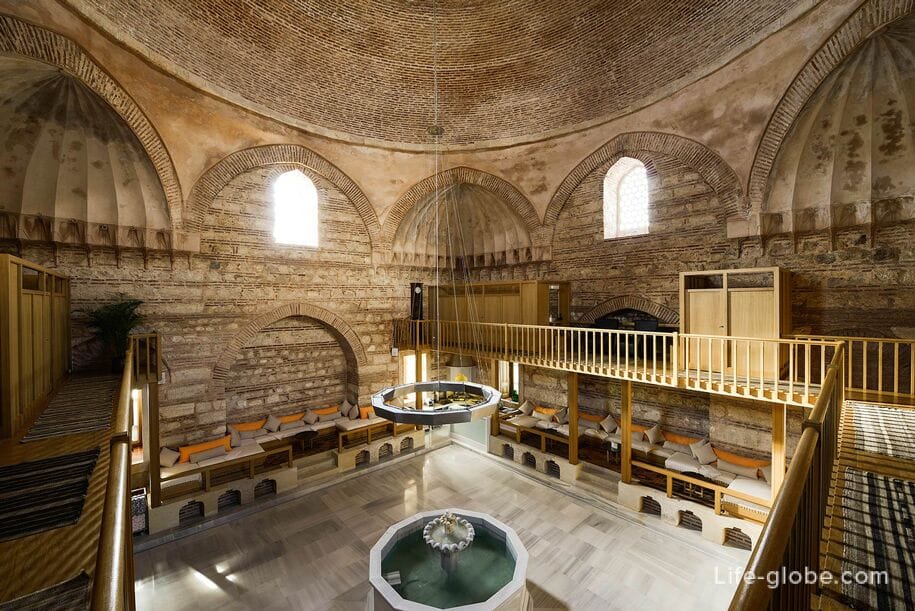
- Agha Hammam (Ağa Hamamı), which is one of the oldest hamams in Istanbul. The hamam was built in 1454 by Sultan Fatih Mehmed the Conqueror and was used as a private hamam of the Sultan and his sons.
In 1844, Abdul-Majid I (the 31st Ottoman Padishah) carried out a large-scale reconstruction of the hammam. The hammam was used by the padishahs and their sons until the last years of the Ottoman Empire.
The services of the hammam include: peeling, massages and masks.
Address of Agha Hammam: Kuloglu Mh., Turnacibasi Cd. No: 48 Aga Hamami, 34433 , Taksim / Istanbul, Turkey.
The site of the Agha Hammam: agahamami.com;
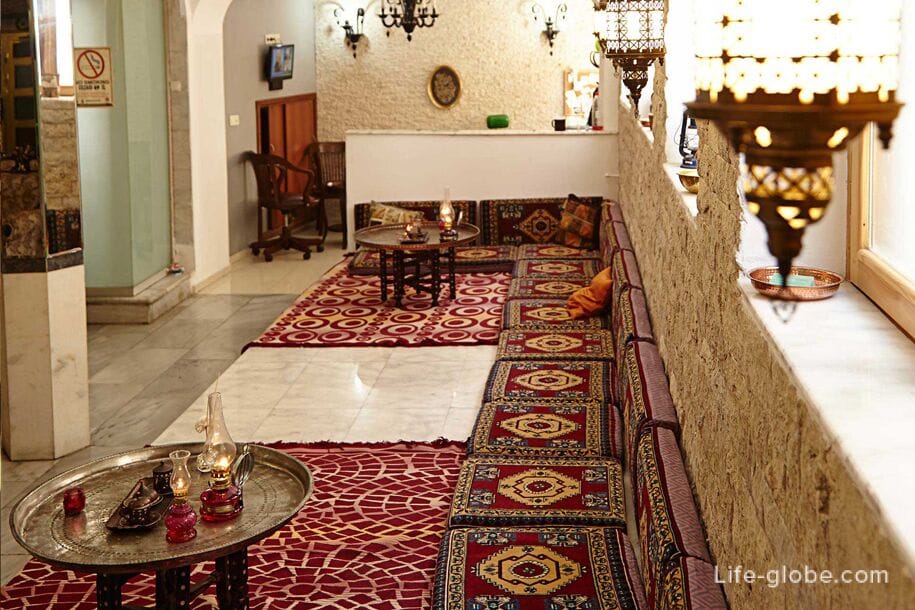

- The Galatasaray Hammam (Galatasaray Hamamı), built by Sultan Bayezid II in 1481 together with the complex of the same name.
The hammam services also include massages.
The address of the hammam: Kuloğlu Mah, Turnacıbaşı Cd. No: 8, 34433 Beyoğlu/İstanbul.
The website of the hammam Galatasaray: galatasarayhamami.com . Learn more about the hammams of Istanbul...
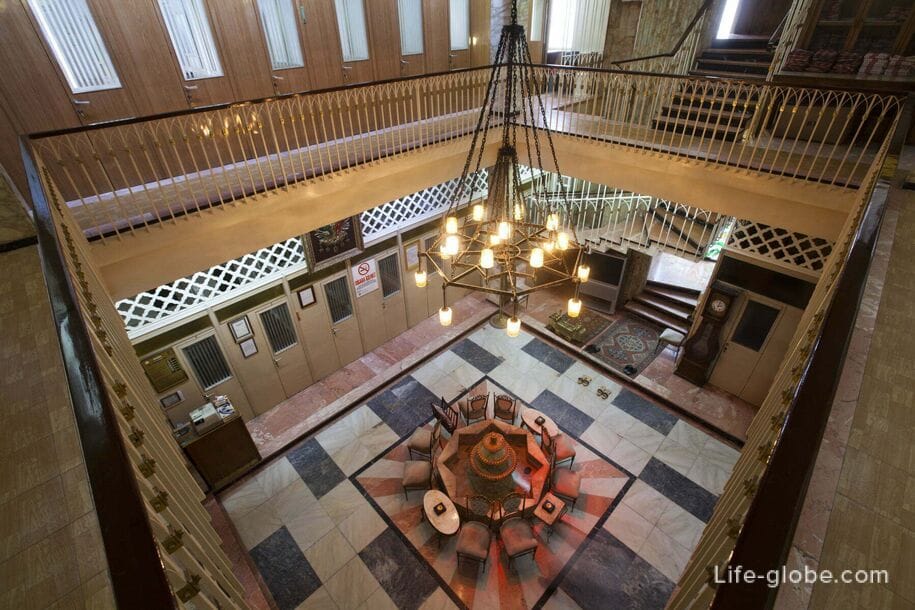

- The Tophane complex is an area that was the oldest industrial zone of the city in the Ottoman era.
The name of this place comes from the armory known as Tophane-i Amire (Tophane-i Amire, Imperial Armory), which was built during the reign of the Ottoman Sultan Mehmed II. The main purpose of the armory was the manufacture of cannons and cannonballs. Today the building is the center of Culture and Art of Tofane-i Amire, which is part of the Mimar Sinan University of Fine Arts.
On the site of the former barracks there is now a historical clock tower (Tophane Saat Kulesi) and the Medjidie mansion.
The monumental fountain of Topkhane (Mahmud Han Çeşmesi), located between the Nusretiye Mosque and the Kilic Ali Pasha complex, was built by order of Mahmud I in 1732;
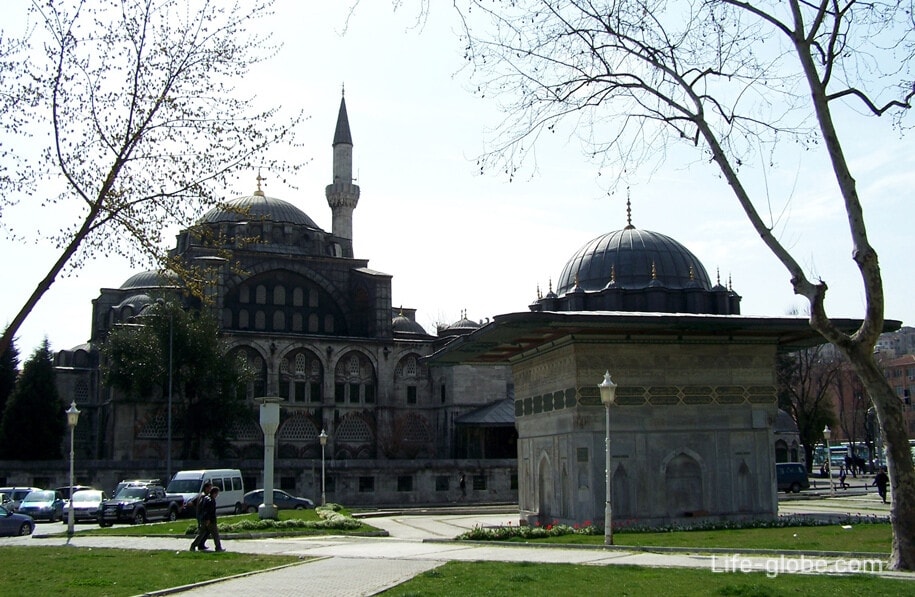
- Nusretiye Mosque (Nusretiye Camii) is an ornate mosque built in 1823-1826 by Sultan Mahmud II.
While the architecture of the mosque has absorbed Islamic elements, it retains the Baroque style, which makes this mosque unique for the city;
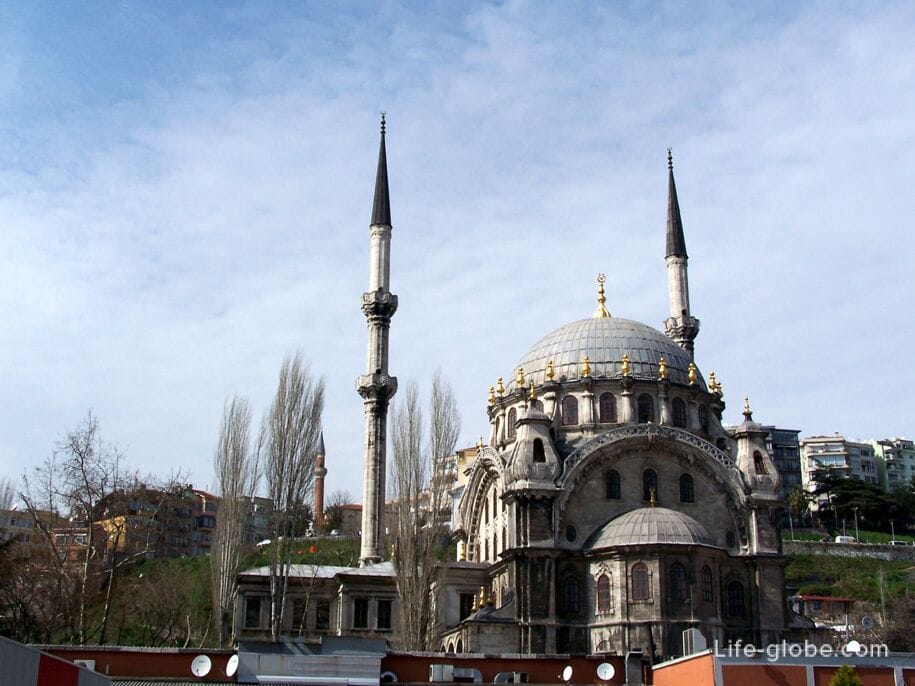
- rainbow staircase (Gökkuşağı Merdiven) is an art object where the steps of a high staircase are painted in colorful bright colors.
They say that the stairs were painted by a Turkish pensioner and spent about 1 thousand dollars on paint. After that, the city authorities allegedly wanted to return the stairs to their former gray appearance, but the surrounding residents staged a picket, and left everything as it is.
This staircase is a photographed and recognizable instagrammable place in Istanbul;
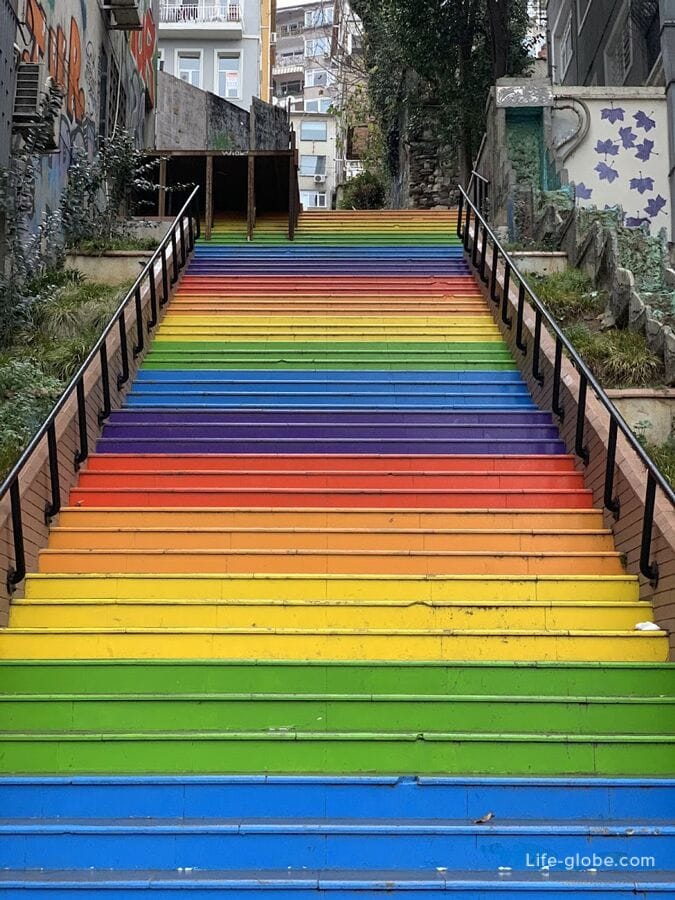
- The Jihangir Mosque (Cihangir Camii), built in 1559 by the famous architect Sinan, by order of Sultan Suleiman I the Magnificent in memory of his youngest son Shehzad Jihangir.
During its history, the mosque was destroyed several times as a result of fires and earthquakes, and after that it was always restored. For the last time, after the destruction in a fire, the mosque was rebuilt in 1874 in the neoclassical style by Sarkis Balyan on the orders of Abdul-Aziz.
The minaret, located to the east of the mosque itself, was built in 1928;
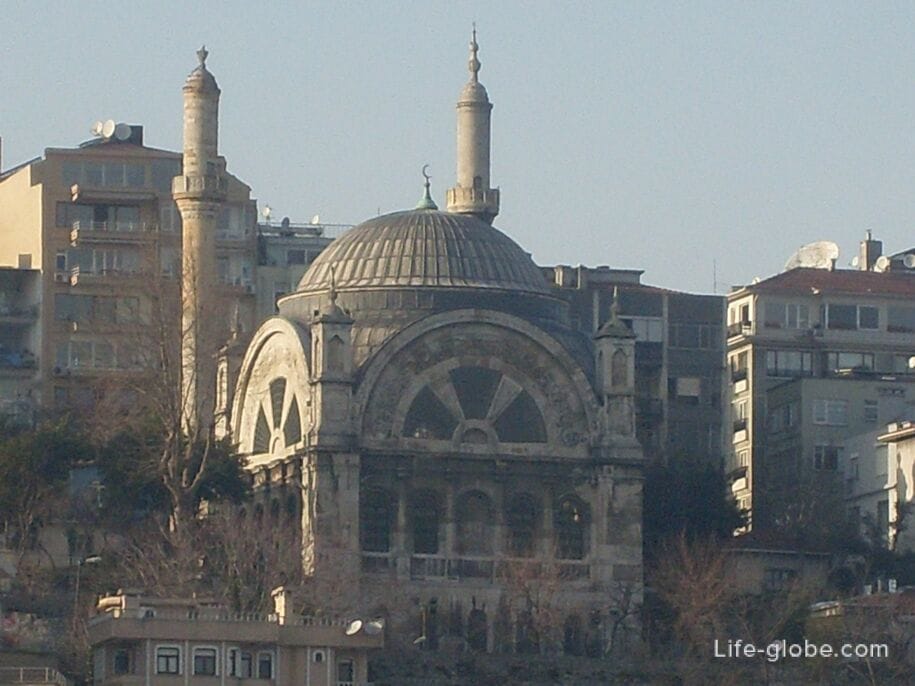
- The mosque of Mullah Çelebi, also known as the Mosque of Findıklı (Molla Çelebi Camii, Fındıklı Cami) is a 16th-century Ottoman mosque commissioned by Kazasker Mehmet Vusuli Efendi, the chief judge of Istanbul, and designed by the imperial architect Mimar Sinan.
According to government sources, the mosque was built between 1561 and 1562. However, there are doubts about the dating, and other sources attribute the period of reconstruction of the mosque to 1570-1584 years.
The structure of the mosque is made in the classical Ottoman architectural tradition.
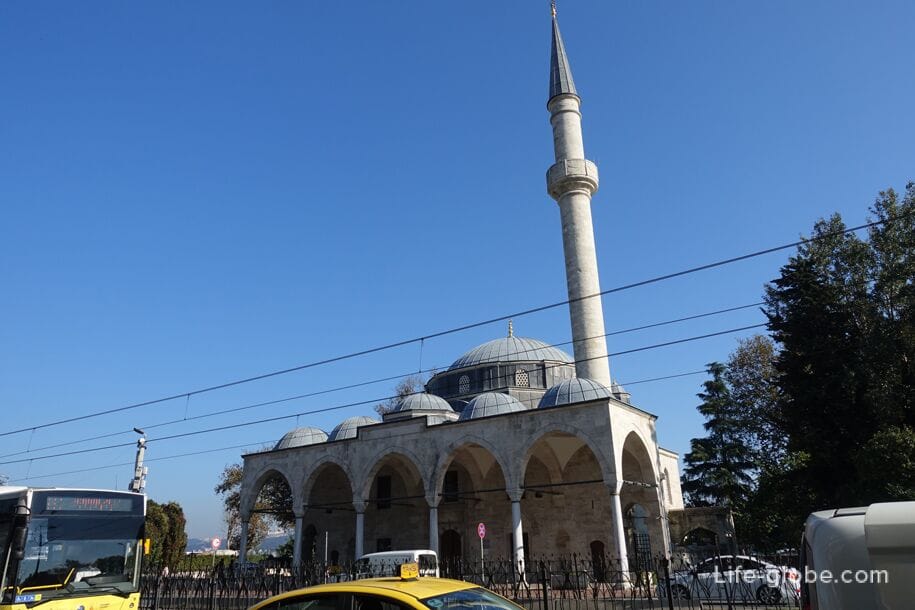

In the area of Karakey, near the waters of the Bosphorus Strait, there is a promenade with a length of 1.2 kilometers, along with a pier.
There are also other exits to the waters of the Bosphorus in the Beyoglu area.
From the Karakei embankment and the exits to the Bosphorus, there are beautiful views of the waters of the Bosphorus and the opposite - the Asian part of Istanbul.
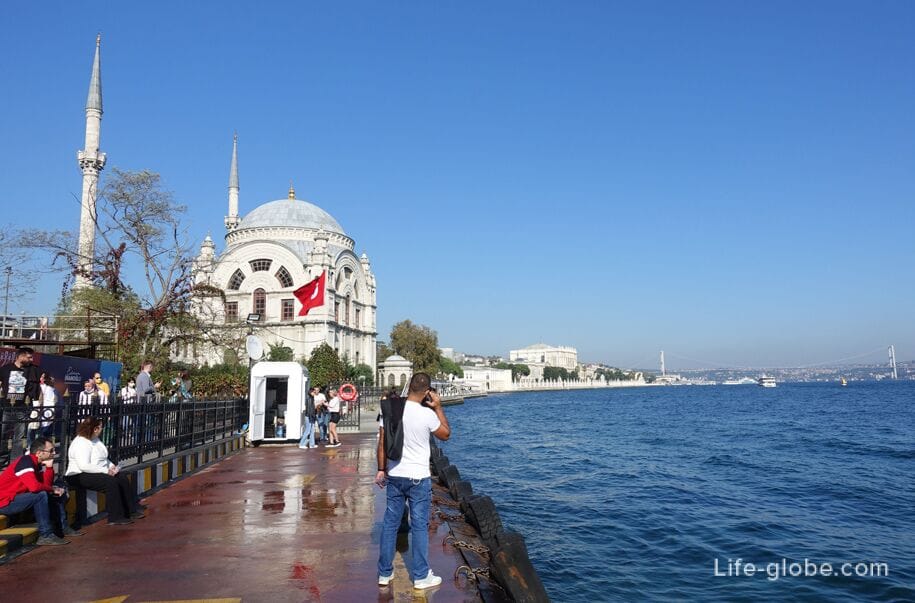
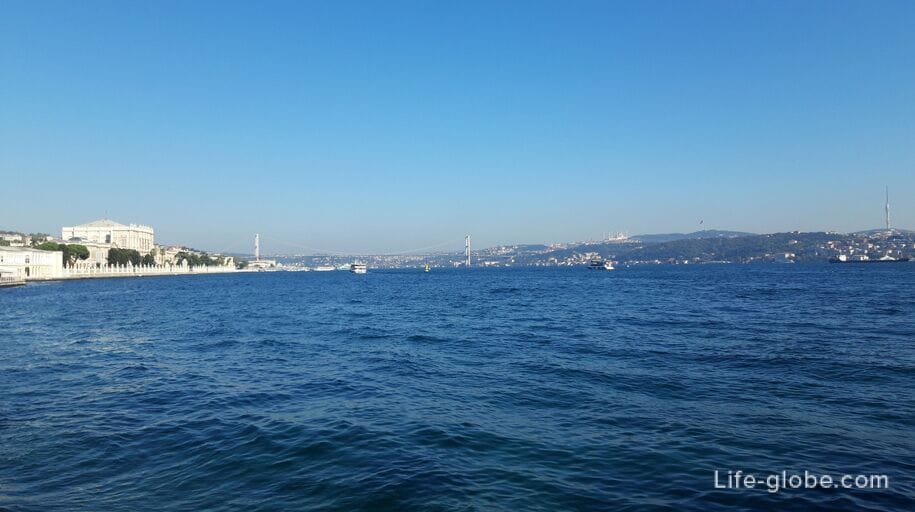
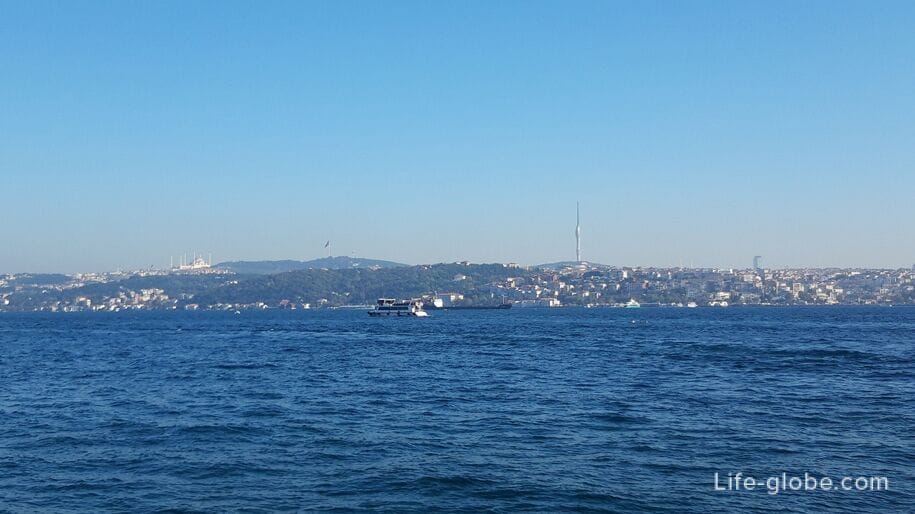
!!! Near the border of Beyoglu district, near the waters of the Bosphorus, in the neighboring Besiktas district, there is a beautiful Dolmabahce Palace (Dolmabahçe Sarayı), which is the second most important and in the history of the Ottoman Empire sultan courts of the city, after Topkapi Palace.
Today, the Dolmabahce Palace is a Museum where you can visit the garden overlooking the waters of the Bosphorus Palace rooms, consisting ofz: the official public part of the "Selamlik" (Selamlık) with function hall (Tören Salonu), Harem (the Harem), or the family part of it; and the clock Museum and the Museum of painting and sculpture (Resim ve Heykel Müzesi). More about Dolmabahce Palace...
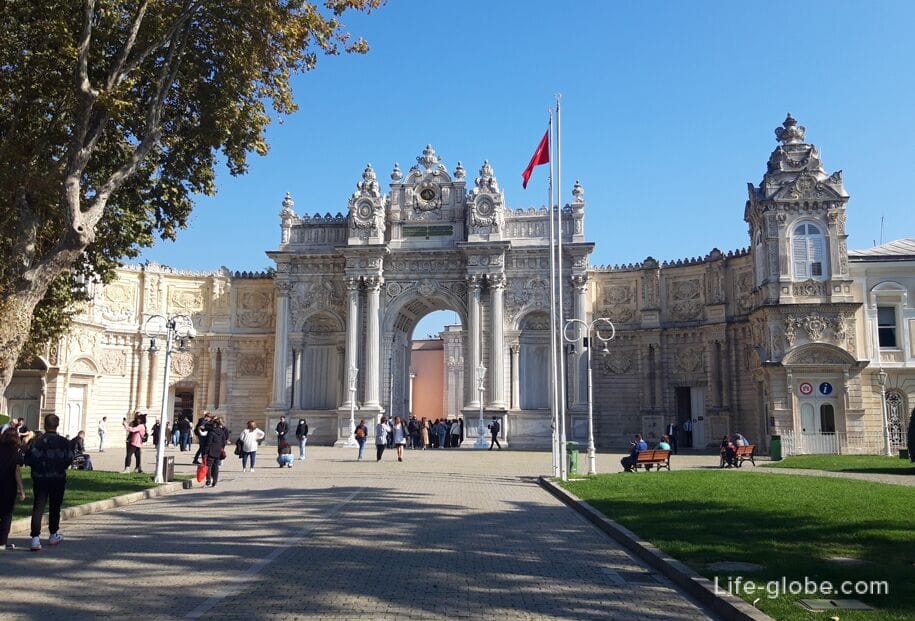
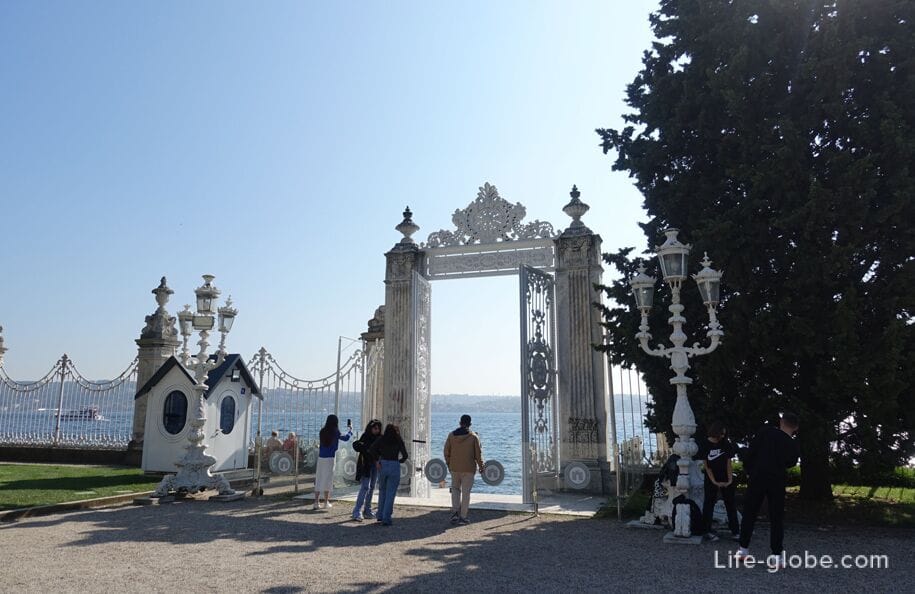


Istanbul Museum of Modern Art (Istanbul Modern Sanat Müzesi, Istanbul Modern) is an art museum where modernist and contemporary art by Turkish and foreign authors are presented, as well as there is a cinema, library, shop and cafe.
On the upper floor of the museum there is an exposition of the permanent collection, rooms for educational programs, a shop and a restaurant, and the lower floor is used for temporary exhibitions, a modern cinema "Istanbul" and a library.
The permanent collection features works by a wide range of artists from Turkey and also works by foreign artists.
Museum address: Asmalı Mescit, Meşrutiyet Cd. No:99, 34430 Beyoğlu/Istanbul, Turkey.
The museum's website: istanbulmodern.org .
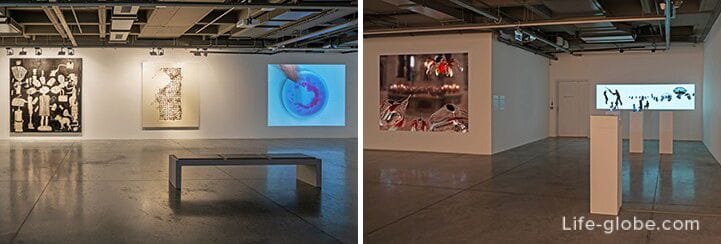
The Pera Muzesi Museum is an art museum located in the elegant building of the former Bristol Hotel, designed by architect Achille Manoussos and built in 1893.
The museum exhibits paintings and ceramics, temporary exhibitions of works by modern masters are held.
The museum pays special attention to orientalism in the art of the 19th century.
The museum's collection of Oriental paintings consists of works by European and Ottoman/Turkish artists, including works by Osman Hamdi Bey and his most famous painting "The Turtle Trainer".
The Anatolian collection of weights and measures includes more than ten thousand copies and consists of items from prehistoric times to those used in modern Anatolia. These include the main types of scales and measuring instruments used to measure weight, length and volume in every field, from land measurement to trade, from architecture to jewelry making, from delivery to pharmacy.
The collections of tiles and ceramics date back to the Kutahya Foundation of Suna and Inan Kiracha (1980s). Today the collection consists of more than 800 items representing various periods, especially the 18th and 20th centuries.
Museum address: Asmalı Mescit, Meşrutiyet Cd. No:65, 34430 Beyoğlu/Istanbul, Turkey.
The museum's website: peramuzesi.org.tr .

The Doganchay Museum (Doğançay Müzesi) is an art museum located in a historic building with an exhibition of works by the Turkish artist and photographer Burhan Doganchay.
This is a mini-retrospective that covers five decades of Doganchai's artistic evolution, starting with his early figurative paintings and ending with photographs. The works of his father Adil Doganchai are exhibited in one hall of the museum.
Museum address: Hüseyinağa, Balo Sk. No:42, 34435 Beyoğlu/Istanbul, Turkey.
The museum's website: dogancaymuseum.org .

The mausoleum of Lohusa Sultan, also known as Rahime Khatun or Saliha Khatun (Lohusa Sultan Türbesi) has an interesting history.
According to the history reflected in the travel book of Evliya Celebi, in 1596, when Sultan Mehmed III went on a campaign, a soldier whose wife was pregnant was also called to the war. Grave Grave When the soldier returned from the war, he found out that his wife had died a few days ago, and in sadness he was praying over the grave and suddenly he hears the sound of a baby from the grave. Rumors began to circulate that a small child was found sucking the breast of his dead mother. When Sultan Mehmed III heard this story, he decided to take care of the child and took him to the palace, after which the child grew up and became a statesman who served the Ottoman Empire. The child was nicknamed Meyitzade, which means "born from the dead".
After the incident with the baby, the tomb-mausoleum "postpartum Khatun" was built by order of the sultan. After that, this place turned into a small cemetery with a family hall, where Evliya Celebi's father and grandfather were buried. After the development of the city, the cemetery was removed, and a small mausoleum remained.
Those who want to have a child come to the mausoleum. The mausoleum is closed to the public.
Mausoleum address: Bedrettin, Refik Saydam Cd. No:30, 34440 Beyoğlu/Istanbul, Turkey.
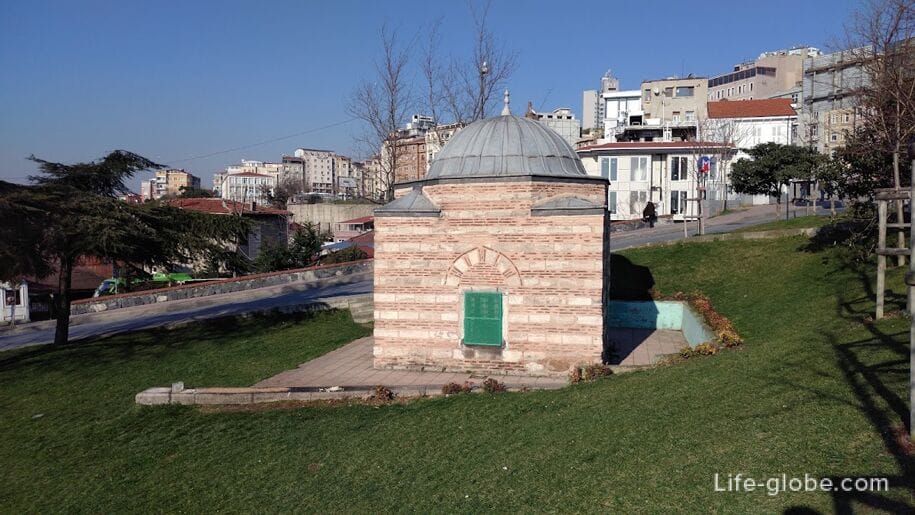
Aynaly Kavak or Aynalykavak (Aynalıkavak kasrı), which is also known as the shipyard Palace, is a summer pavilion that has been preserved from the Ottoman Sultan's palace complex and which was considered the fourth largest palace of the Ottoman Empire, after the Topkapi, Dolmabahce and Beylerbeyi palaces.
According to some sources, the construction of structures began during the reign of Mehmed II the Conqueror. Another version says that the complex is identical to the reign of Suleiman the Magnificent. The palace complex included numerous buildings and gardens. Over the course of history, the buildings were supplemented until the complex was destroyed as part of Selim's innovative movements.
Today, the preserved (now restored) Ainalikavak Pavilion is one of the most elegant legacies of classical Ottoman architecture that has survived to the present day.
Within the walls of the palace pavilion there is a museum with beautiful halls.
Pavilion address: Keçeci Piri, Donanma Cd., 34440 Beyoğlu/Istanbul, Turkey.
Museum website: aynalikavak-kasri.

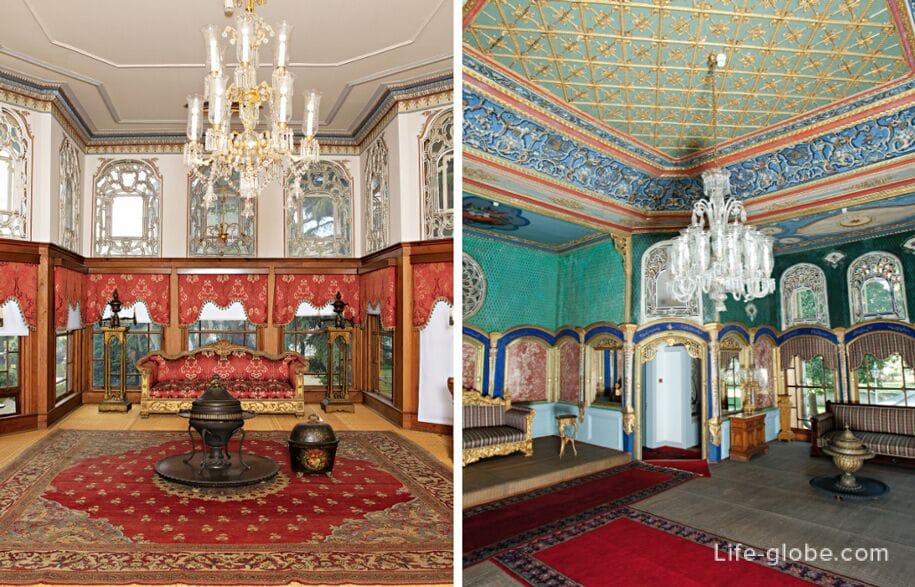
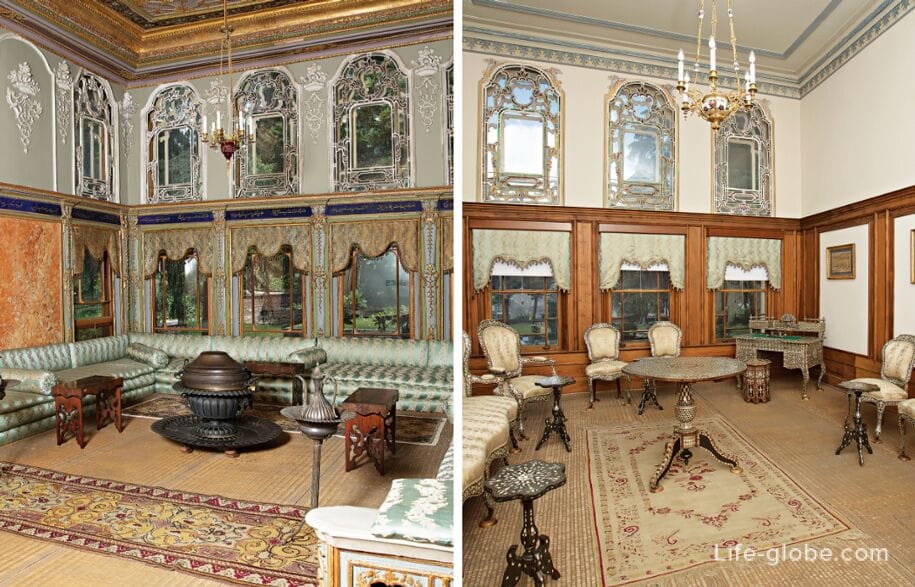
The Piyale Pasha Mosque (Kasımpaşa Büyük Piyale Paşa Camii) is a 16th-century Ottoman mosque with six domes, prayer halls and stained glass windows.
The mosque was designed by the Ottoman Imperial architect Mimar Sinan for the Vizier and Grand Admiral Piyale Mehmed Pasha. The construction took place between 1565 and 1573.
Unlike other mosques in the city designed by Sinan, which have a large central dome, the Piyale Pasha Mosque consists of six identical domes arranged in two rows of three in each. This is one of the two mosques in Istanbul with several domes, the second is the Vasat Atik Ali Pasha Mosque (Vasat Atik Alipaşa Camii) in the Fatih district. The domes are supported in the center of the prayer hall by a pair of slender granite columns.
In the domed octagonal mausoleum to the northwest of the mosque is the grave of the founder of the Piyale Pasha mosque, along with the tombs of his sons and daughters. There are thirteen sarcophagi in total. His wife, Gevherkhan Sultan (daughter of Selim II), remarried and was buried in the mausoleum of Selim II at Hagia Sophia Mosque.
Mosque address: Kaptanpaşa, Sel Sk. No:4, 34440 Beyoğlu/Istanbul, Turkey.
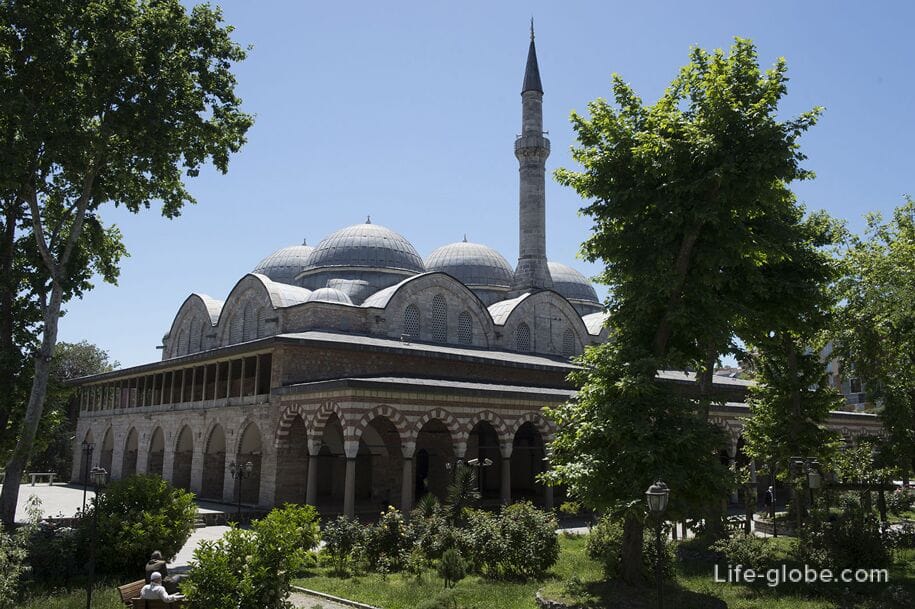
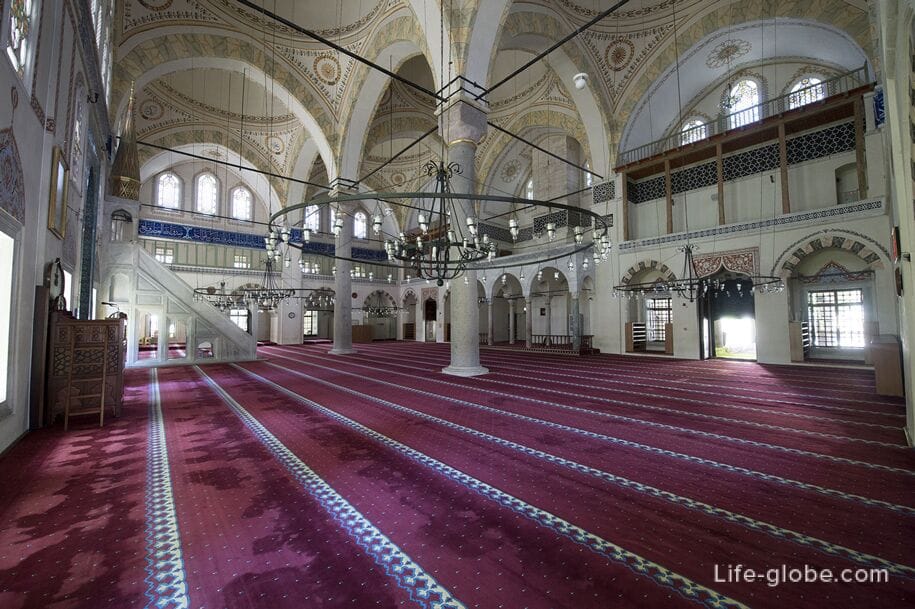
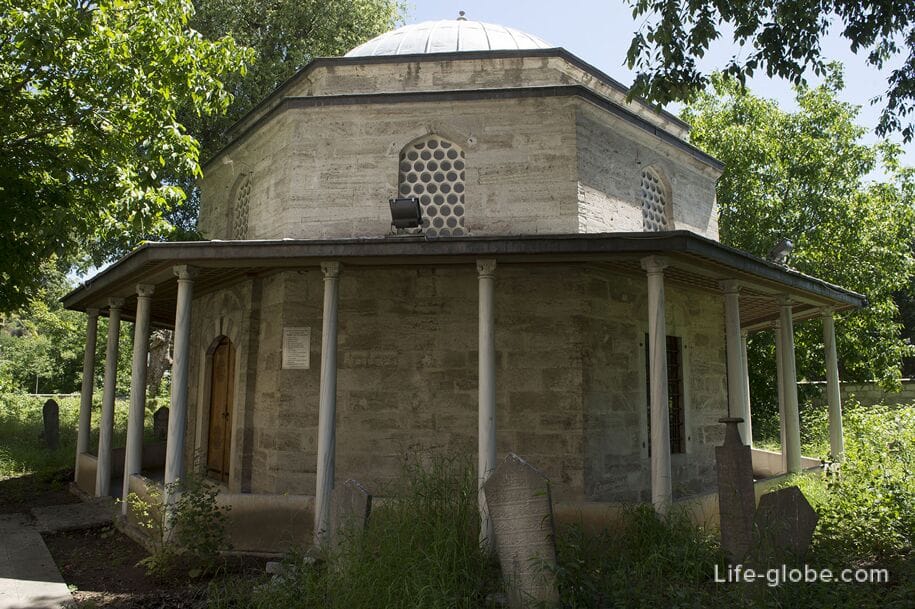
The Museum of Contemporary Art of the Vehbi Koc Foundation (VKV Çağdaş Sanat Müzesi) is a cultural and educational center where temporary exhibitions and various events in the context of contemporary art are held throughout the year, in addition to the collection of contemporary art of the Vehbi Koc Foundation.
Address: Yenişehir, Irmak Cd., 34435 Beyoğlu/Istanbul, Turkey.
Adam Mickiewicz Museum (Şair Adam Mickiewicz Müzesi) is a memorial house-museum dedicated to the memory of the life of the famous Polish poet Adam Mickiewicz.
Adam Mickiewicz lived and died in the museum house. The poet arrived in Istanbul in September 1855 to help organize a Polish regiment of the Ottoman Army to fight the Russian Empire during the Crimean War. He became friends with Mikhail Tchaikovsky (Sadik Pasha), who commanded the Polish troops.
On November 8, 1855, Adam Mickiewicz, Armand Levy and Henrik Sluzalski rented a small house from Mrs. Rudnitskaya, where the poet spent his last days. The room was simple and sparse. The poet himself considered this room temporary before a planned trip to the Balkans. Nevertheless, it was here that he died of illness on November 26, 1855.
The house burned down in a fire in March 1870 and in the same year the Polish aristocrat Jozef Ratynski bought this land from the municipality of Istanbul. Ratynsky built a reconstruction of the first house on the site, exactly the same as the one that burned down.
The museum in the house was opened in 1955. The crypt in which Mickiewicz was temporarily buried is located in the basement, and Adam Mickiewicz's manuscripts, historical documents and paintings are also kept in the museum.
Museum address: Bostan, Tatlı Badem Sk. No:10, 34435 Beyoğlu/Istanbul, Turkey.
The museum's website: muze.gov.tr/muze-detay .
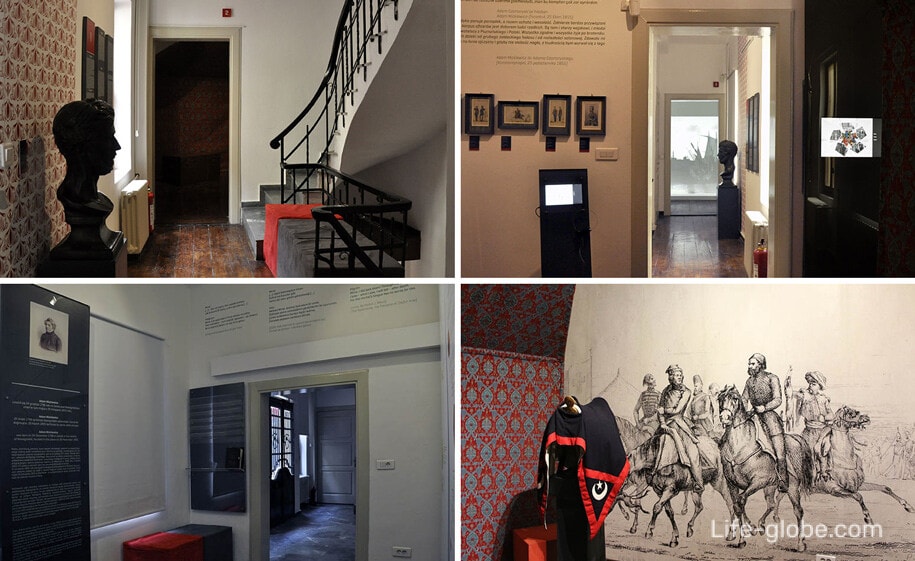
Rahmi Kocha Museum (Rahmi M. Koç Müzesi) is dedicated to the history of transport, industry and communications with a collection of cars and interactive exhibits.
During the visit, guests of the museum will learn about its founder - Turkish philanthropist, collector and millionaire Rahmi Mustafa Koc, a representative of one of the richest dynasties in Turkey.
The museum's exposition mainly consists of the personal collection of the creator, from ancient gramophone needles to steam locomotives. There are also vintage cars, motorcycles and an Istanbul tram, scientific instruments, toys, models, communications equipment and even an American submarine. And in the practical gallery, you can sit in the cockpit of an airplane, drive an old car, or conduct scientific experiments.
Museum address: Piri Paşa, Aziz Sk. No: 5, 34445 Beyoğlu/Istanbul, Turkey.
The museum's website: rmk-museum.org.tr .
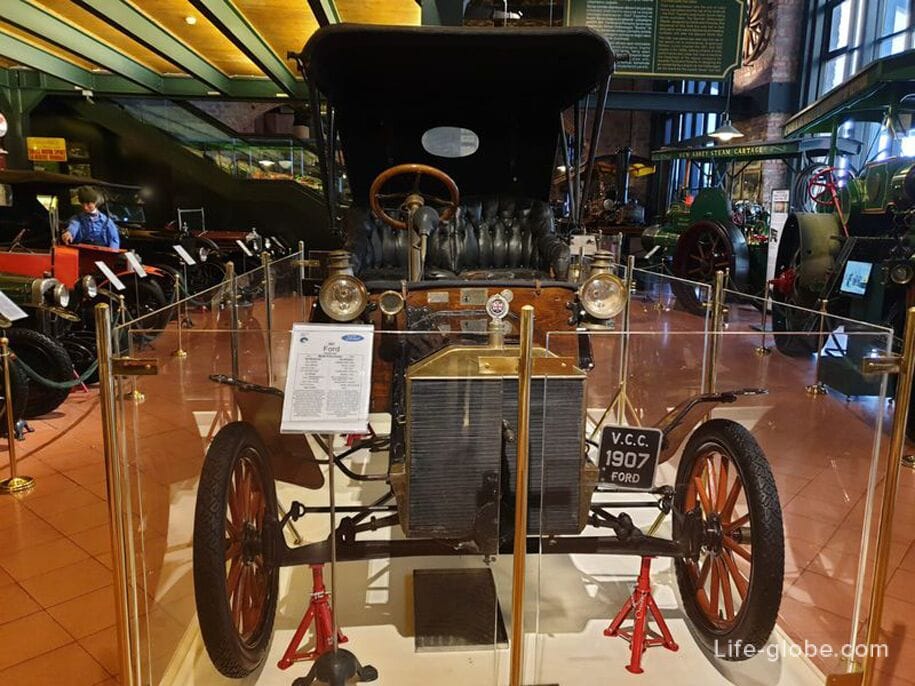
Miniatürk Park (Miniatürk) is a theme park created under the slogan "A small model of a big country" in which there are miniature copies of Turkish attractions, fromThe Blue Mosque and Topkapi Palace to the white terraces of Pamukkale, the temple of Armetida and the Mausoleum of Halicarnassus.
In the park there are miniature models of 136 architectural works, including 60 works from Istanbul, 63 works from Anatolia and 13 works from Ottoman geography outside Turkey, reduced to a factor of 1:25.
The address of the park: Ernektepe, Imrahor Cd. No:7, 34445 Beyoğlu/Istanbul, Turkey.
Miniaturk Park website: miniaturk-istanbul-muzeleri-bilet.
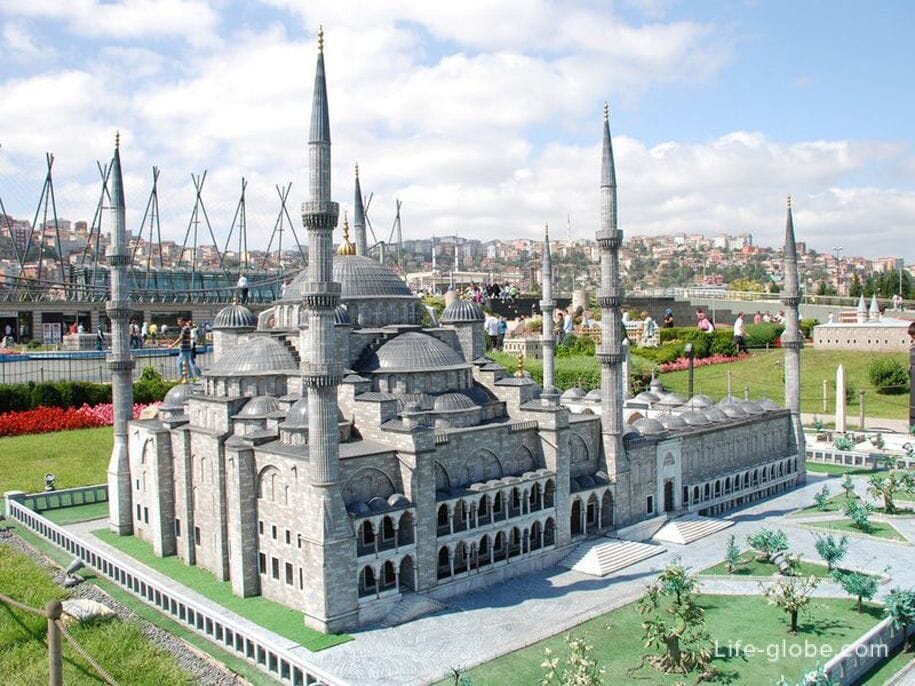
The Beyoglu area can be reached by public transport, car or taxi.
Buses, trams, metro and funiculars run from public transport to and around the district.
In addition, ferries run from the ferry berths of the district, both through the Golden Horn and the Bosphorus in Istanbul, and outside the city.
Istanbul ferries are public transport (Istanbul transport cards are valid).
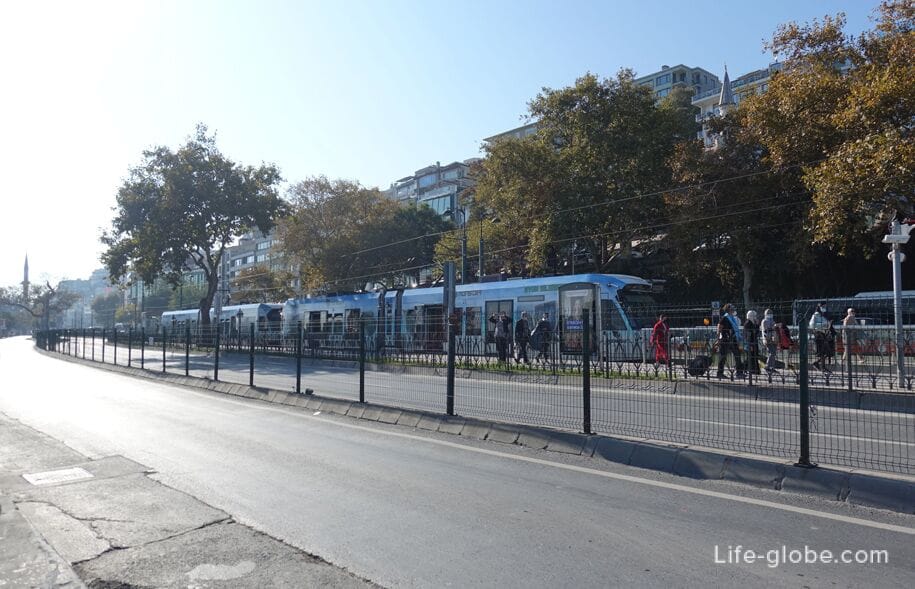
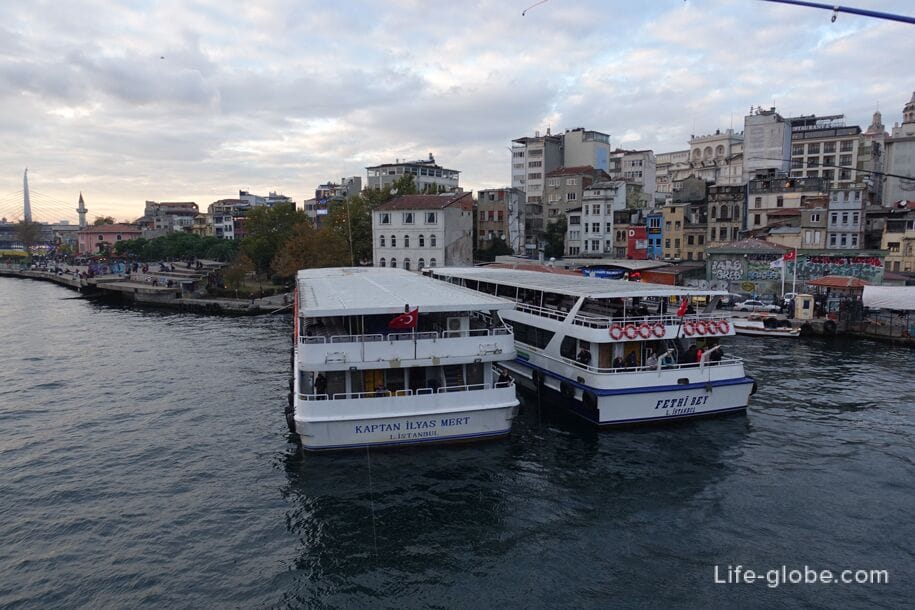
You can also visit the Beyoglu district by taking a tour on the Istanbul Hop-On Hop-Off tour bus.
There are tickets for 1, 2 or 3 days.
In the Beyoglu area, buses make stops in Karakey and near the port, near the Istanbul Museum of Modern Art and Taksim Square.
Tickets for the Istanbul sightseeing bus can be purchased here →
Some museums and sites in Istanbul, including those located in the Beyoglu district, have museum and tourist maps.
There are different types of maps in Istanbul. Some of which give the right to visit certain museums, while others, in addition to the main museums, include excursions, as well as some shows and entertainment, public transport rides and discounts on airport transfers.
The classic and most common is the museum card "Museum Pass Istanbul" (Museum Pass Istanbul), which gives the right to enter some museums of the city. There are also more extended Istanbul E-Pass and Istanbul Tourist Pass cards, which give the right to visit museums, attractions, guided tours, an aquarium, shows, cruises along the Bosphorus, trips outside the city, etc. Learn more about museum and tourist maps of Istanbul...
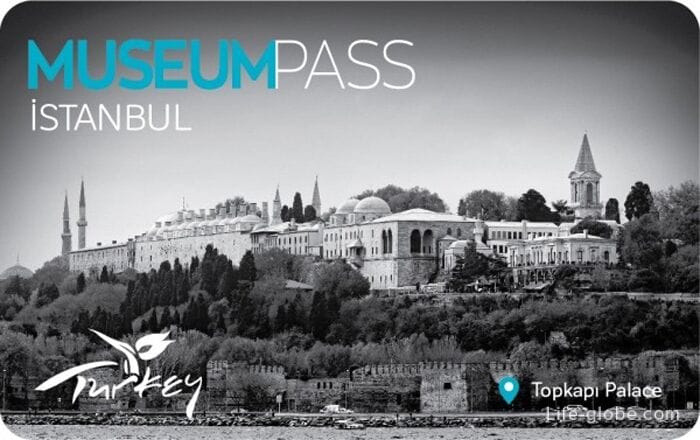
In the Beyoglu area, especially on and near Taksim Square and Istiklal Street, there are a lot of cafes and restaurants, including Turkish cuisine and with panoramic terraces.
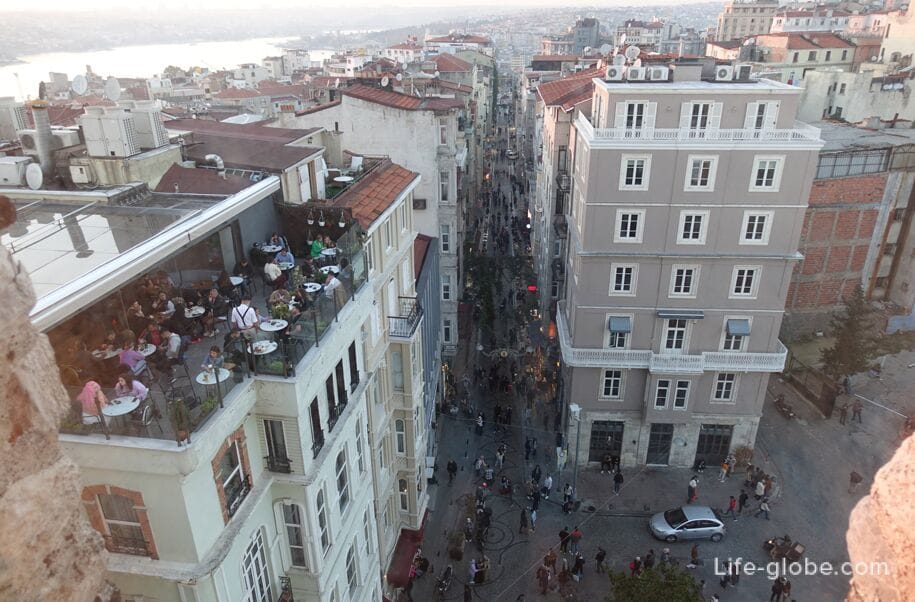

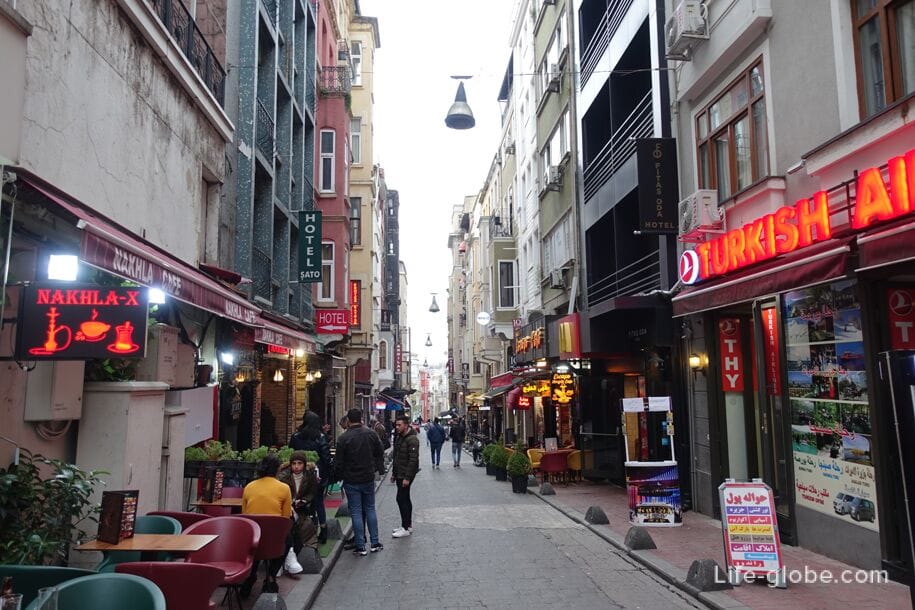
There are also bars, coffee shops, snack bars, hookah bars and nightclubs.
Dessert cafes include the Hafiz Mustafa 1864 dessert cafe chain with varied and delicious baklava, lukum and other desserts. Learn more about Hafiz Mustafa dessert cafes with photos and website...
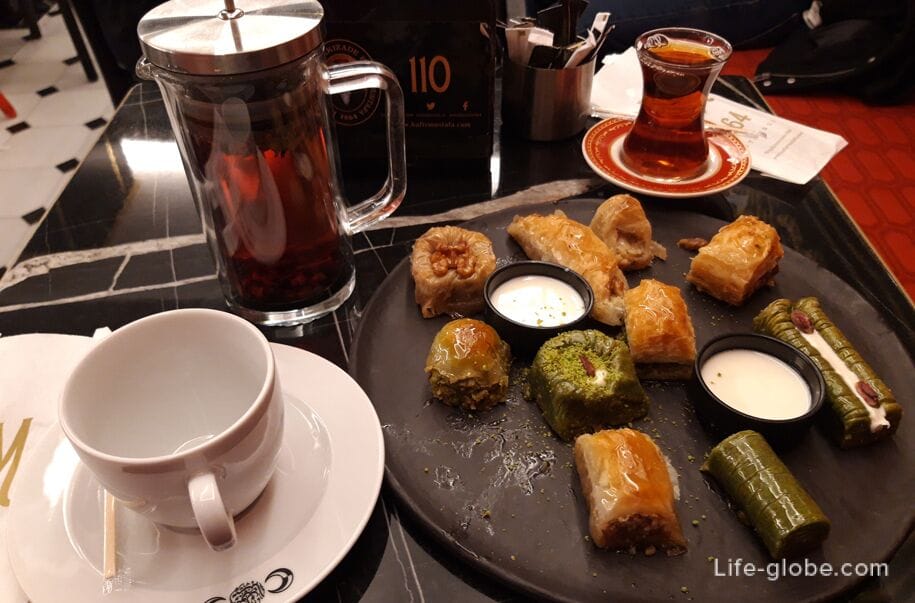
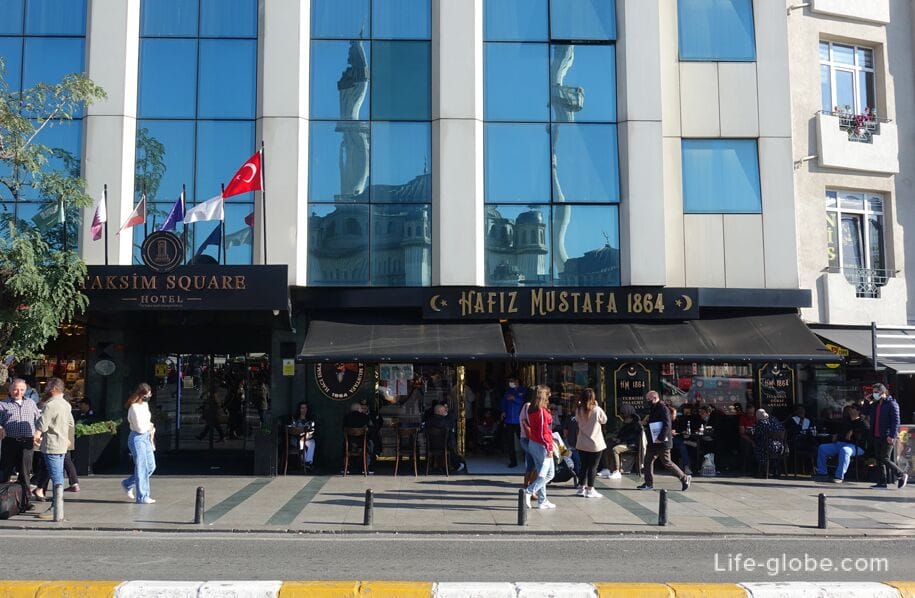
There is a large selection of accommodation facilities in the Beyoglu area, ranging from 5-star boutique hotels with panoramic terraces and apartments (full-fledged apartments with all amenities), ending with budget guest houses and hostels.
There are also hotels with views of the Bosphorus and the Beoglu district, for example,
5-star hotel The Peninsula Istanbul, which is one of the most luxurious in Istanbul and consists of four exquisite buildings, three of which are historical and beautifully restored.
At the hotel: private territory with a promenade near the waters of the Bosphorus, an outdoor pool with a terrace with sun loungers and a view of the Bosphorus, a 25-meter indoor pool, a restaurant, a lobby, spa and fitness centers, free Wi-Fi and facilities for disabled guests.
The rooms range in size from 40 to 89 squares. In the rooms and suites: mini-bar, safe, flat-screen TV, cable channels, air conditioning, heating, hairdryer, iron, coffee/tea maker, work desk, seating area, bath, bathrobes, slippers and free toiletries. Link to the hotel
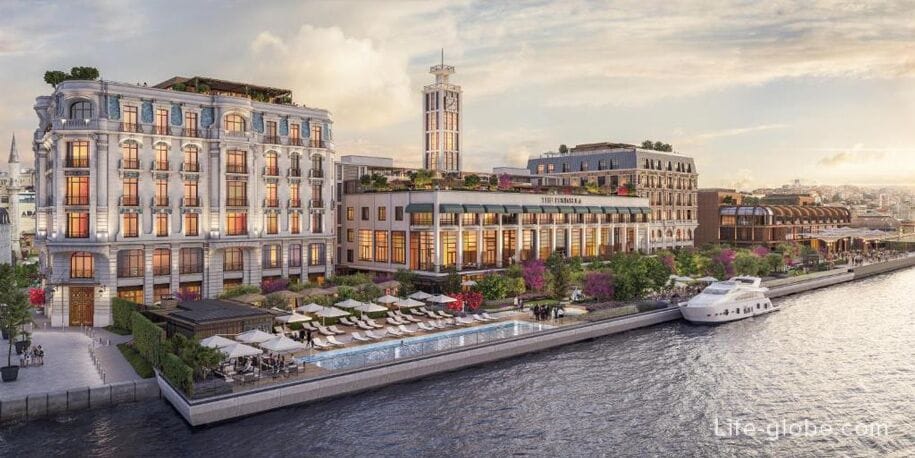

The 5-star Novotel Istanbul Bosphorus Hotel features an indoor pool, a spa with massage room, sauna, steam room, Turkish bath and fitness center, free Wi-Fi and parking.
Some rooms offer views of the Bosphorus and the historical part of the city.
The room rate can include: breakfast or breakfast + dinner. Link to the hotel

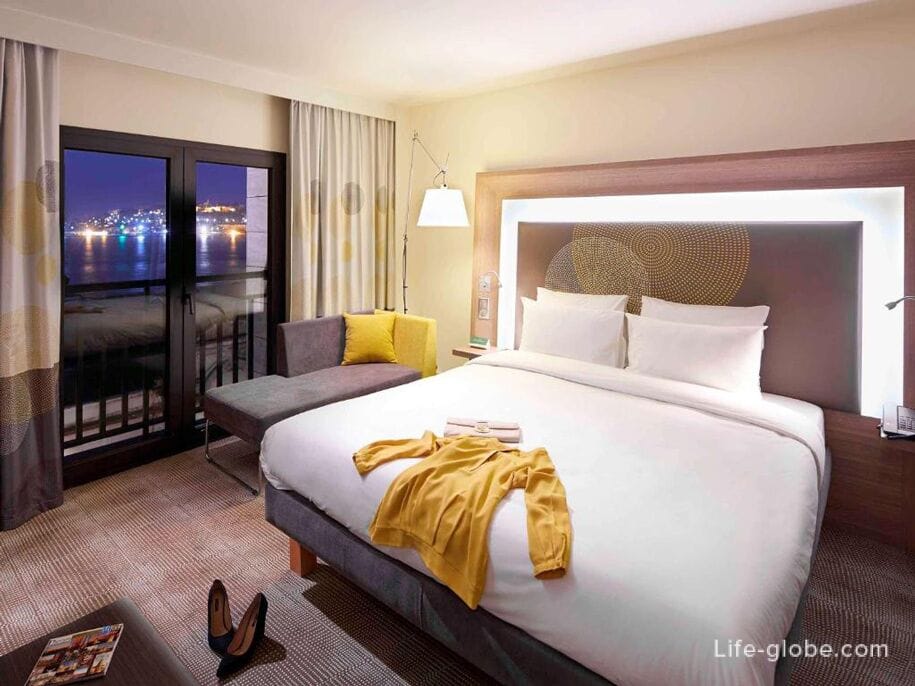
The 5-star JW Marriott Istanbul Bosphorus Hotel features a restaurant, a bar, a seasonal outdoor pool, a fitness center, a wellness and spa center, free Wi-Fi and a 24-hour front desk.
The hotel has rooms with views of the Bosphorus or the historical part of the city (Beyoglu district).
The room rate includes: breakfast or breakfast + dinner. Link to the hotel
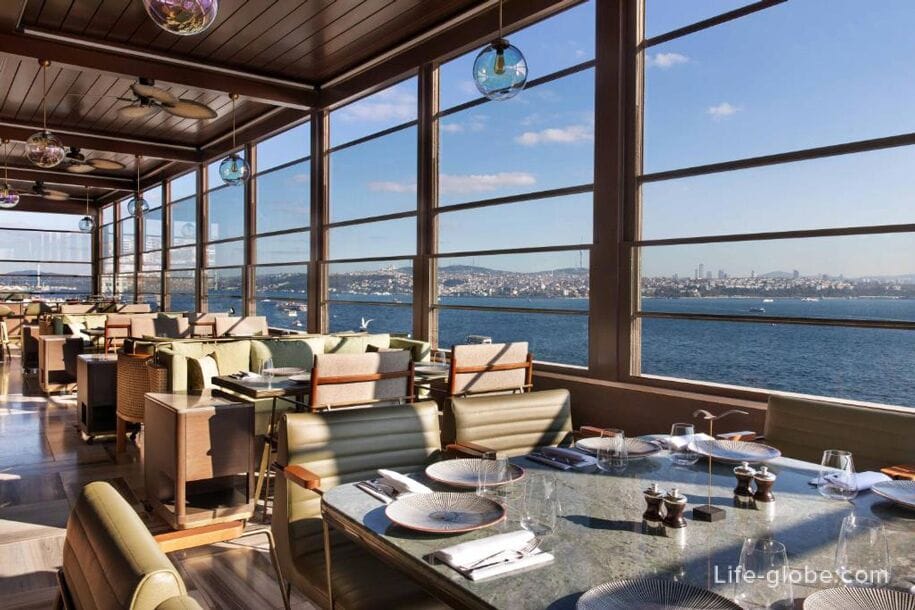
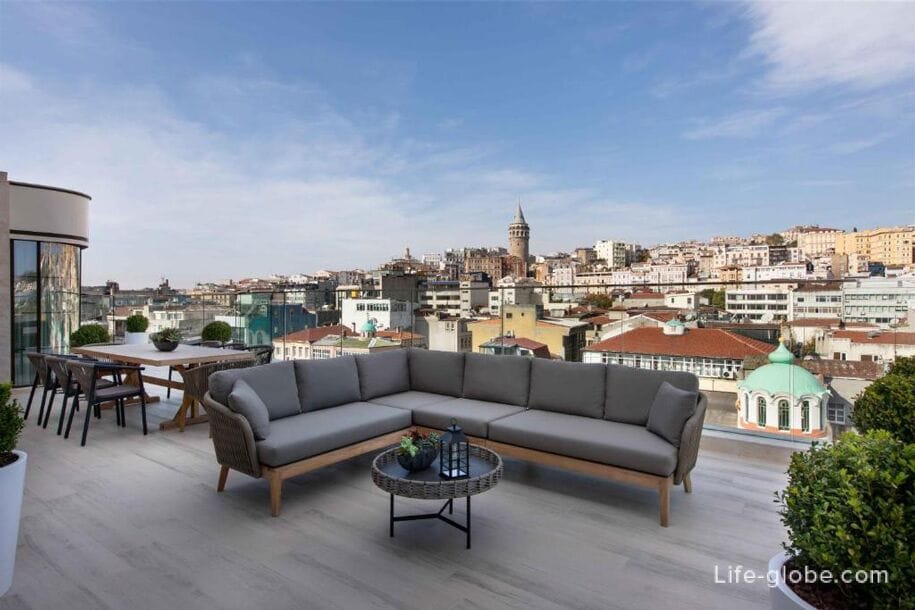
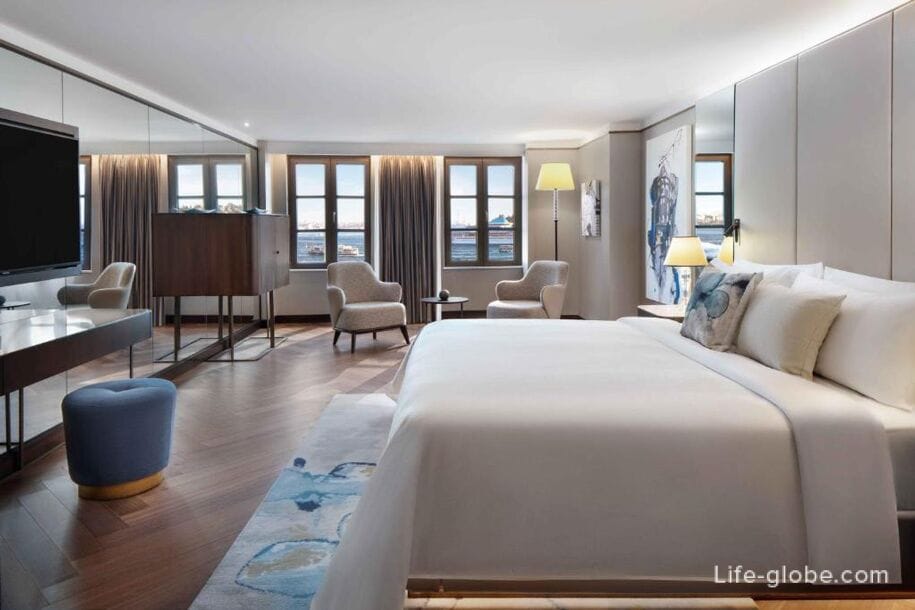
All accommodation facilities in the Beyoglu area can be viewed and booked here
